

San Francisco Tourism Statistics
Page last updated: 06 August 2024
San Francisco , located in California on the west coast of the United States, is known for its iconic Golden Gate Bridge, lively neighbourhoods, bustling Chinatown, and historic landmarks, making it a popular destination for travellers worldwide.
How many tourists visit San Francisco each year?
San Francisco consistently draws over 23 million visitors each year, excluding the pandemic period. 1
- In 2019, the city reached its peak with 26.2 million visitors, including 2.95 million international visitors.
- However, the COVID-19 pandemic caused a sharp decline in 2020, with only 11.8 million visitors, a 55% drop from the previous year, and overseas visitors dropped to 500,000 .
- The city began to recover in 2021, attracting 17 million visitors, a 44% increase from 2020, with international tourists increasing slightly to 560,000 .
- Tourist numbers grew to 21.9 million in 2022 (including 2 million international tourists), but this figure was still 16% below 2019 levels.
- Over 23.1 million visitors travelled to San Francisco in 2023, with 2 million being international visitors.
- In 2024, the city expects to welcome around 23.7 million visitors, with 2.36 million expected to be international tourists. 2
- San Francisco’s visitor volume is expected to reach 2019’s 26 million in 2026.

How much do visitors spend in San Francisco every year?
Visitors spent a total of $8.8 billion in San Francisco in 2023, with international visitors contributing $4.64 billion to this figure.
- In 2019, tourists contributed $9.56 billion to San Francisco’s economy, including $5.11 billion from international visitors.
- In 2020, the total fell by 72% to $2.66 billion due to the pandemic, with international spending dropping to $980 million .
- The year 2021 brought signs of economic recovery, with total tourism expenditures rising to $3.56 billion and international tourists contributing $1.17 billion .
- The recovery continued in 2022, with expenditures rising to $7.46 billion , including $3.67 billion from international visitors, a 110% increase from 2021, but still 22% below 2019 levels.
- By 2023, visitor spending grew to $8.8 billion , with $4.64 billion from international tourists, an 18% increase from the previous year.
- Projections for 2024 anticipate a total spend of $9.45 billion , with international visitors expected to contribute $5 billion .
- Visitor spending in San Francisco is expected to surpass 2019’s levels by 2025 .

Where do visitors to San Francisco come from?
Oxford Economics’ 2022 and 2023 data indicated that the majority of visitors to San Francisco were from Mexico , the United Kingdom , Canada , India , and Germany . Although the precise numbers are unspecified, it’s clear that San Francisco’s appeal stretches across different continents. 3
How many people visited San Francisco in 2022?
In 2022, San Francisco welcomed 21.9 million visitors , marking a 29% increase from 2021 but still 16% less than the 26.2 million in 2019.
- Of the 2022 figures, over 2.19 million international tourists visited San Francisco. This indicated a 211% jump from the lows of 2020 and 2021 but still 41% down compared to pre-pandemic levels.
How much did visitors spend in San Francisco in 2022?
Tourism spending in San Francisco reached $7.46 billion in 2022, which was 110% more than the $3.56 billion spent in 2021.
Despite this increase, tourist spending remained 22% lower than the pre-pandemic level of $9.56 billion in 2019.
- International visitors accounted for $3.67 billion of the total tourism revenue for the city in 2022.
Impact of Coronavirus – San Francisco Tourism Statistics 2020 and 2021
- The COVID-19 pandemic significantly impacted San Francisco’s tourism in 2020, resulting in a drastic reduction in both visitor numbers and spending. The city only welcomed 11.8 million visitors , a 55% decrease from 2019, while spending plummeted to $2.7 billion , 72% less than the previous year. International tourists decreased to 500,000 (an 83% drop ) with their spending falling by 81% to $980 million .
- In 2021, tourism began to recover, with visitor numbers increasing to 17 million and spending rising to $3.6 billion . International visitors saw a 12% increase to 560,000 , and their spending rose by 19% to $1.17 billion . This recovery marked a positive trend as the city adapted to post-pandemic conditions, leveraging its appeal to gradually restore its tourism industry.
When is the best time to visit San Francisco?
- The best time to visit San Francisco is during the fall, from September to November . This period, often referred to as the “Indian Summer,” offers warm temperatures and the city is less crowded compared to the summer months.
- Spring is another good time to visit, offering mild temperatures and blooming flowers.
- Summer tends to be foggy and crowded, while winter is cooler and rainy.
What’s the best way to travel in San Francisco?
- In terms of getting around, the best ways to explore San Francisco are on foot and by public transportation. The city’s layout makes it easy to visit numerous attractions within walking distance of each other, and its municipal transit system, including the iconic cable cars, is convenient.
- However, if you decide to rent a car for more flexibility or to venture outside the city, there are numerous car rental agencies available in San Francisco.
USA Travel Resources
- Car rental prices in San Francisco – comparison
- Car rental prices in the USA
What are the top tourist attractions in San Francisco?
- Pier 39 : As one of San Francisco’s most visited attractions, Pier 39 welcomes over 10 million visitors annually. It features sea lion sightings, iconic city views, chowder tasting, and wine sampling.
- Golden Gate Bridge : The iconic Golden Gate Bridge, known for its architecture and panoramic views of the bay and the city, attracts about 10 million visitors each year. No visit to San Francisco is complete without seeing this landmark.
- Ferry Building Marketplace : With around 4 million annual visitors, the Ferry Building Marketplace is a vibrant hub for foodies and shoppers. It showcases local farmers and artisans in a lively atmosphere.
- California Academy of Sciences : This museum, featuring an aquarium, planetarium, and natural history exhibits, offers an educational experience to its 1.5 million annual visitors.
- San Francisco’s Chinatown : As the oldest Chinatown in North America, this district provides a dynamic cultural experience with its shops, temples, and eateries, drawing approximately 2 million visitors annually.
How many days are needed to experience all that San Francisco has to offer?
- A stay of three to five days is recommended to fully experience San Francisco and its major attractions.
- This duration allows visitors to explore popular sites such as the Golden Gate Bridge, Alcatraz Island, Fisherman’s Wharf, and various neighbourhoods like Chinatown and Haight-Ashbury.
Where are the best places to stay in San Francisco?
- Visitors have a wide range of lodging options from luxury hotels to budget-friendly guesthouses. Popular areas to stay include Union Square, Fisherman’s Wharf, and the Embarcadero, which are central to major tourist sites.
Is tourism up or down in San Francisco?
Whether tourism in San Francisco is up or down is a subject of debate. On one hand, there are indications of recovery and improvement within the tourism sector after the downturn caused by the COVID-19 pandemic. On the other hand, the city’s perceived reputation , as viewed by some, is cited as having an impact and potentially “killing tourism across the Bay Area.”
Here are some key factors influencing tourists’ hesitation:
- High Costs: San Francisco is known as one of the most expensive cities in the United States, both in terms of living and visiting. The high costs associated with accommodations, dining, and services can be a significant factor for tourists on a budget.
- Homelessness and Safety Concerns: The city has a visible homelessness issue and has faced challenges with crime rates in certain areas, which may discourage some visitors, but not all are affected equally.
- Cleanliness: Reports of cleanliness issues in certain areas of the city have circulated in the media and on social platforms, potentially discouraging visitors.
- Crowds and Tourism: Popular attractions and neighbourhoods can become very crowded, especially during peak tourist seasons, which might be off-putting for some visitors seeking a more relaxed experience.
- Pandemic Impact: The tourism sector is still recovering from the effects of COVID-19. Issues such as reduced flight availability, changing travel regulations, and health concerns may continue to impact tourist numbers.
The city and tourism industry stakeholders are actively addressing these challenges through various measures, including:
- Enhanced Safety Measures: Increasing police presence and security initiatives in popular tourist areas to reassure visitors.
- Cleanliness and Sanitation Efforts: Programs aimed at improving the cleanliness of streets and public spaces, and addressing sanitation concerns.
- Homelessness Initiatives: Efforts to provide more support and services to the homeless population to mitigate the impact on the city’s streets and public spaces.
- Marketing and Communication: Focused marketing efforts to highlight the positive aspects of San Francisco, its attractions, and the steps being taken to address the city’s issues.
While San Francisco faces challenges, it remains a city with incomparable attractions, vibrant culture, and beautiful landscapes. Awareness and action on these issues are key to revitalising its tourism industry and ensuring visitors can enjoy all that San Francisco has to offer.
Popular US Tourist Attractions
- Disneyland Resort Statistics
- Grand Canyon Statistics
- Statue of Liberty Statistics
- Yellowstone National Park Statistics
- Walt Disney World Statistics
- Universal Orlando Statistics
- Universal Studios Hollywood Statistics
America Travel Statistics Resources
- Toronto Statistics
- Mexico Statistics
- Panama City Statistics
- Peru – Machu Picchu Statistics
- California Statistics
- Chicago Statistics
- Denver Statistics
- Florida Statistics
- Hawaii Statistics
- Las Vegas Statistics
- Miami Statistics
- New York Statistics
- Orlando Statistics
- SFTravel : Visitor Volume and Direct Spending Estimates – 2022 ↩︎
- SFTravel : 2023 Visitor Impact Results and 2024 Forecast ↩︎
- SFTravel : International Visitor Volume and Spending – Top Market ↩︎
Where have all the tourists gone? San Francisco travel industry lags in post-pandemic return
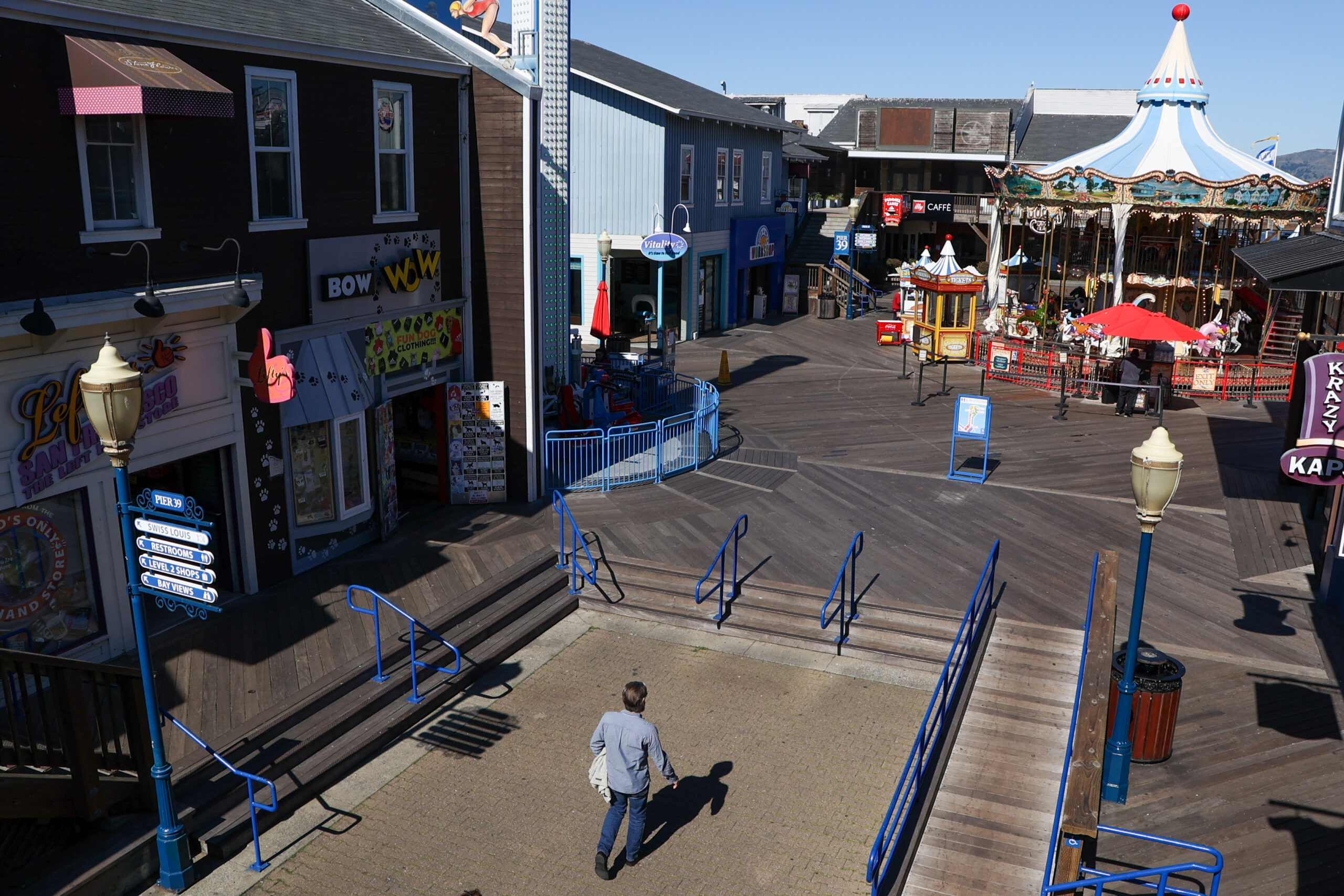
- Copy link to this article
San Francisco’s battered tourism industry is starting to see the early signs of a recovery—but a few key factors remain depressed—leading the city’s tourism board to say the market won’t fully recover to pre-pandemic levels until 2024.
The San Francisco Travel Association reported there were 14.8 million visitors to the city in 2021, a 25% boost from 2020. Spending by visitors also jumped to $3.1 billion from 2020’s $2.8 billion figure.
Those modest increases are still a far cry from the record levels the city saw in 2019 when visitors reached 26.2 million people, and spending hit $10.3 billion, including spending on meetings and conventions.
Signs of a Turnaround
The sparks of recovery were also seen on the ground. John Holst has been giving Segway tours of San Francisco since 2016, and he said there’s no question the pandemic has been difficult.
“We had to close down for several months until we could re-open because of Covid,” said Holst, the general manager of San Francisco Electric Tour Company.
But he’s seen business pick up in the months since, even during the Omicron wave. “This has been one of our busiest seasons in the past three years, and that includes prior to the pandemic,” he added.
Another encouraging change, according to Holst? More support from residents on Lombard Street who view the tours as a sign of life for San Francisco rather than a backyard nuisance.
Visits to the Golden Gate National Recreation Area have also returned to pre-pandemic levels. The National Park Service reports 13.7 million total visitors in 2021, which is almost up to 2019 visitorship of 15 million. The NPS believes residents are helping to keep this visitor traffic up. Alcatraz Island may be a better gauge of tourist traffic to the GGNRA, but because it was closed for much of the pandemic, visitors dropped from 1.6 million in 2019 to 643,000 in 2021.
Before the pandemic, more than 86,000 jobs were supported by tourism in the city. While the number of jobs supported by tourism in San Francisco increased 31% from 2020 to 27,318 in 2021, it’s still less than a third of pre-pandemic figures.
Headwinds Continue
One previously huge segment that has continued to lag has been international travel. The 481,000 international visitors that San Francisco saw in 2021 were actually 4% lower than 2020 and down 84% from 2019’s 2.9 million figure. While international visitors comprised only 11% of overnight visitor volume, they were responsible for 44% of all overnight visitor spending in 2021.
The San Francisco Controller’s Office agreed. Their recent economic recovery report shows international enplanements climbed to 40% of pre-pandemic levels as of year-end 2021 but troubling times continue for the hotel industry.
Conventions—previously a major driver of group travel—have still not returned to pre-pandemic levels, a problem some attribute to a decline in street conditions and worries about public safety. Since the Moscone Center’s reopening last September, only 38 meetings have been held or are scheduled at the venue through 2022.
The impact on the hotel industry has been well documented. Average hotel occupancy is only around 35.5% and average daily room rates are down 41% to $162.37 compared to 2019 numbers.
All that adds up to a major drop in the city’s revenue from lower tax and fee contributions. The tourism industry generated $257.4 million in taxes and fees for San Francisco in 2021, down 69% from $819.7 million in 2019.
San Francisco’s travel industry has historically been very strong because it is a “triple threat,” attracting pleasure, business and conferences travelers. With only half of its tourist market on the rebound, and the other two sectors just beginning to come back to life, it is no wonder that the SF Travel believes recovery to pre-Covid levels will take until 2024.
“It’s really a tale of two types of cities,” says Emmy Hise, director of analytics for real estate data company CoStar Group. Some leisure-focused markets, such as Miami, have already rebounded from the pandemic, while markets more dependent on corporate and group travel, such as San Francisco, Chicago and New York, continue to struggle.
Kevin Truong can be reached at [email protected]
Filed Under
Effortless booking
Maximize online conversions with the most intuitive checkout online.
Expand revenue with our powerful Automated E-commerce tools.
Upgrade your website to industry’s best. Fresh websites. Fresh revenue.
Amplify visibility and expand earnings with integrated OTAs and local partners.
Streamline check-ins, limit risk, and amplify customer data with built-in digital waivers.
Transform data into insights. X-ray reporting gives you customer and business intelligence.
Manage high-volume walk-up customers effortlessly with POS, ticketing, and gated entry.
Automate management of staff schedules, assignments, and staff communications
Control your business precisely the way you want with endless yet easy configurability.
Allocate equipment used in various products. Prevent overbookings and maximize profits.
Grow with Xola in our constantly expanding universe of integrations and apps.
Harness customer data to drive marketing campaigns and generate repeat business.
Transform your guests into passionate brand advocates. Perfect your products & services.
Manage your business with the most powerful mobile suite in the industry.
Perfect the guest experience by giving your staff the industry’s most intuitive software.
Efficiently manage guest flow, minimize wait times, and ensure maximum satisfaction.
Ticketing & Entry
Revolutionize your guest experience: Effortless check-ins, interactive displays, secure payments.
Boost revenue with automated rave reviews, actionable insights, and loyal customer engagement.
Efficient ticketing, digital waivers, and fast check-ins enhance on-site operations and guest satisfaction.
Explore Xola Universe: 80+ apps, limitless integrations, endless growth opportunities.
Simplify check-in and boost your marketing efforts with our integrated automated digital waivers.
With SOC 2 Type II and CCPA compliance Xola exceeds industry security standards and insures your data protection.
Access real-time insights for business growth with our powerful reporting.
Remarkable and hassle-free guest experiences with waitlist and virtual queuing.
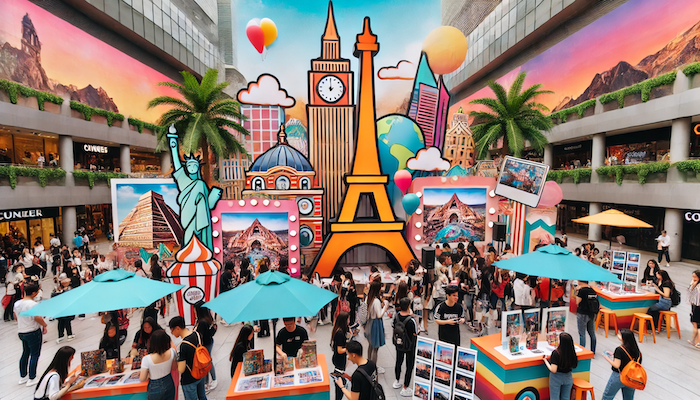
What is a brand activation, and why is it important for travel brands?
- Xola University
- Business Operations
San Francisco tourism stats round-up post

With its hilly streets, colorful homes, and scenic coastline, San Francisco is one of the most beautiful cities in the U.S.
Up until the pandemic, over 25 million visitors from the U.S. and beyond visited the Northern California city every year. As the travel industry recovers, people are once again starting to visit San Francisco for its atmosphere and ambiance, scenic beauty, and restaurants and cuisine.
If you’re an attraction or tour operator looking to better understand the city’s tourism market, look no further. In this post, we’re breaking down the past three years of San Francisco tourism statistics.
How many tourists visit San Francisco each year?
About 26 million people visited San Francisco in 2019, the last normal year before the Covid-19 pandemic. That number dropped significantly over the past two years, but the city is now on its way to recovery.
The city is forecast to reach 21.9 million visitors in 2022, with overall visitor spending growing to $6.1 billion — an impressive increase from the $3.1 billion spent in 2021.
Yet it won’t be until 2024 that visitor numbers return to pre-pandemic levels by 2024.
SF Tourists in 2021
In 2021, San Francisco welcomed 14.8 million visitors to the city. This was an increase of 25% from 2020 — but down 44% from a record-high of 26.2 million visitors in 2019.
SF Tourists in 2020
Only 10.2 million visitors traveled to San Francisco in 2020. The steep 61% decline from 2019 was due to the pandemic, which curbed domestic and international travel for most of the year.
SF Tourists in 2019
2019 was a record year for San Francisco. About 26.2 million visitors traveled to the city that year, up 1.4 percent from the 25.8 million that visited in 2018.
SF Monthly Tourism Numbers
About 2 million people visited San Francisco every month in 2019, before numbers began trickling down due to the pandemic.
SF Weekly Tourism Numbers
About half a million people visited San Francisco every week in 2019.
SF Daily Tourism Numbers
In 2019, an average of 71,805 people visited San Francisco each day. In 2020, that figure dropped to 27,911 visitors . As visitors began to return to the city, the average daily visitor count went up to 40,519 in 2021.
How much money does tourism bring to San Francisco?
In 2019, San Francisco had a record-breaking tourism year. The industry generated $819.7 million in taxes and fees for the city, an increase of 6% over the previous year. Hotel taxes represented 51% of that figure, and property tax contributed 21%.
Meanwhile in 2020, the tourism industry only generated $273.4 million , down 66.6% from the nearly $820 million in 2019.
Ongoing travel restrictions and the lack of conventions kept tourism revenue down last year, too. Only $257.4 million was generated in 2021, down 6% from 2020 and down 69% 2019.
Which Demographics Want to Visit San Francisco the Most?
San Francisco’s travel industry is known as a “triple threat” because it attracts pleasure, business, and conference travelers alike. And the city keeps travelers coming back time and time again: Only 24.4% are first-time visitors.
Most (85.6%) of San Francisco’s visitors are on vacation. Aboout 7% are traveling for business purposes, and another 7% are visiting for a convention.
It’s also worth noting that the city also attracts affluent tourists whose average household income is $94,637 .
How many Americans visit San Francisco each year?
Most of San Francisco’s visitors are Americans. Of the 26 million people who visited in 2019, about 23 million came from the U.S. In 2021, the city welcomed 14.3 million Americans (and only 500,000 international visitors ).
Top airports of origin for tourists that visit San Francisco
These are the top three domestic airports of origin by number of flights:
- Los Angeles International Airport in California
- Seattle-Tacoma International Airport in Washington
- Las Vegas McCarran International Airport imn Nevada
How many international tourists visit San Francisco each year?
San Francisco welcomed 2.9 million international visitors in 2019. In 2020, that number dropped to 570,000 international visitors .
Ongoing lockdowns and Covid-19 outbreaks further hampered international tourism to the city in 2021.
The number of international visitors dropped again to 481,000 in 2021, which represents a 4% dip from 2020 and an 84% decrease from 2.9 million in 2019.
Top countries that have the most tourists that visit San Francisco
In 2019, San Francisco’s top five international markets were:
- 3. United Kingdom
- 5. Germany.
Meanwhile, the fastest growing markets were France, Italy, and Taiwan.
Now, the top five markets are made up of Mexico, India, Canada, the Netherlands, and Taiwan.
How Much Do Tourists Typically Spend in San Francisco?
San Francisco visitors spent a record $10.3 billion in 2019. Visitor spending totaled to $26.2 million per day — or $1.1 million per hour.
The average visitor spent about $365 per day, while convention attendees spent about $584.
International visitors spent $5.1 billion in 2019, a whole lot more than their domestic counterparts. Before Covid, international visitors accounted for over 60% of all overnight visitor spending , even though they represented just 28% of the city’s visitors.
As a result of the pandemic, visitor spending in San Francisco dropped 80% in 2020. In 2021, total spending increased to $3.1 billion, up from $2.8 billion in 2020 but down 70% from 2019.
Share of tourism spending/revenue in SF by country of origin
The top five markets for visitor spending in 2019 were China, the United Kingdom, India, South Korea, and Australia. In 2021, the top five markets were swapped to include Mexico, India, Canada, Taiwan, and the Netherlands.
How Many Hotel Rooms Are In San Francisco?
There are about 34,000 hotel rooms in San Francisco. Average hotel occupancy was 82.9 percent in 2019 with average daily rates hitting $277.
How many tours and attractions are in San Francisco?
There are hundreds of tours and attractions available in San Francisco.
The leading attractions visited include:
- The Golden Gate Bridge
- Golden Gate Park
- The Ferry Building
Top 20 San Francisco Tourism Attractions by the numbers
- More than 24 million visitors put Golden Gate Park on their San Francisco bucket list. Golden Gate Park is the third most-visited city park in the country.
- About 13.7 million people visited the Golden Gate National Recreation Area in 2021, which is close to the number of people that visited in 2019 (15 million).
- More than 10 million people flock to the Golden Gate Bridge every year.
- The Presidio welcomes 7.5 million visitors each year and is also home to 200 organizations and 3,000 residents.
- About 2 million people visit the “crooked” section of San Francisco’s Lombard Street every year.
- Only 643,000 people visited Alcatraz Island in 2021, compared to 1.6 million in 2019.
- More than 1.2 million visitors go to Crissy Field every year to walk and bike the promenade.
- San Francisco Museum of Modern Art (SFMOMA) is the nation’s largest museum of modern and contemporary art. The newly expanded museum welcomed 1.2 million visitors during its first year.
- Nearly 1 million people visited the Fort Point National Historic Site in 2021.
- The Exploratorium welcomed about 1 million visitors every year.
- Over 650,000 people visited the beautiful redwood at Muir Woods National Monument in 2021.
- Nearly 500,000 people attend over 200 concerts and presentations of the San Francisco Symphony each year.
- More than 155,250 people wander through Union Square’s shops on a given day.
- The California Academy of Sciences attracts about 80,000 visitors every year.
- The Asian Art Museum is home to a collection of 18,000 artworks spanning 6,000 years and every corner of Asia.
- A record 37,000 visitors took a tour at Oracle Park, the home of the San Francisco Giants. Over 300 private tours are conducted annually.
- Nearly 20,000 people visit Angel Island every year.
- The Contemporary Jewish Museum has welcomed more than 1.2 million visitors in the last ten years. Nearly 20,000 attend through school, youth, and family programs every year.
- The San Francisco Zoo and Gardens is home to more than 1,000 exotic, endangered and rescued animals.
- The de Young showcases American art from the 17th through 21st centuries, boasting more than 25,000 works of art on display from around the world.
San Francisco is one of the most visited cities in the U.S. If you’re contemplating opening a travel business in the city, know that the tourism industry is slowly recovering to its pre-pandemic days. Visitor numbers and spending are expected to reach pre-pandemic levels between 2024 and 2025.
Writer Carla Vianna

Related Articles
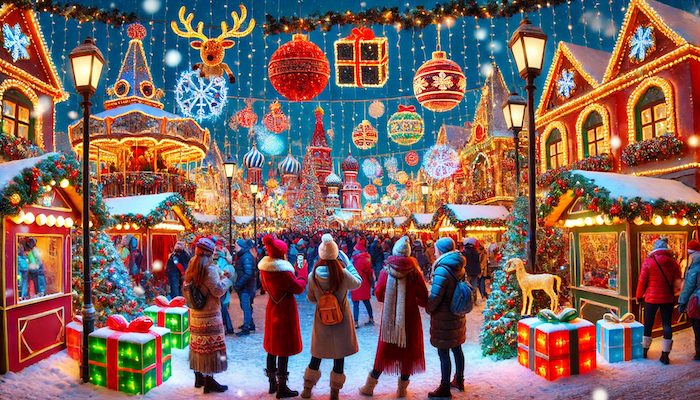
Why your holiday park may not be reaching its full potential
When you own and operate a holiday park, speed is king. You don’t have the luxury of having off days

Why responding to Tripadvisor reviews is essential
Did you know that your company may already be listed on Tripadvisor, even if you didn’t list it yourself? If

The ultimate guide to capacity planning
It’s the first week of your busiest season, and the number of bookings rolling in is higher than ever before.
Get the latest news and resources.
For tours and attractions delivered straight to your inbox each week.
Transform your business now.

Hotel Occupancy Rate
San Francisco's four-month rolling average hotel occupancy rate.
Measure Description
Why this measure is important, how performance is measured, additional information, city performance scorecards.
The Hotel Occupancy Rate indicates the share of San Francisco hotel rooms booked monthly. It is a key indicator of the strength of the City's tourism industry. Tourism is a key component of San Francisco's economy and is a major source of revenue for local businesses and government. The Hotel Occupancy Rate is a Citywide demand indicator; therefore, no City department is directly responsible for the measure's monthly performance.
Reporting on the Hotel Occupancy Rate provides the public, elected officials, and City staff with a current snapshot of San Francisco's tourism sector.
In 2019, prior to the COVID-19 pandemic, more than 26 million visitors travelled to San Francisco. In 2023, 23.1 million people visited the City, making up $9.3 billion in business revenues. During that same period, the Hotel Occupancy Rate increased from a low of 13% to its peak of 79% in October 2023. The Hotel Occupancy Rate remains a key indicator of the City's recovery in the tourism sector since the pandemic.
The interactive line chart below presents the monthly four-week rolling average of the San Francisco's Hotel Occupancy Rate.
The chart's legend is below:
- Y-Axis : Hotel occupancy rate percentage
- X-Axis : Calendar years
Navigating dashboards with a keyboard
- Control + Enter to enter the dashboard
- Tab or Arrow to move between visuals
- Control + Right arrow to enter a visual or filter
- Escape to exit a visual, filter or dashboard
Navigating within a visual or filter
- Tab or Arrow to move around a table or visual
- Enter to select within a table or visual
- Spacebar to select or deselect a filter
Hotel Occupancy Rate is the number of booked hotel rooms divided by the number of available hotel rooms in a given night.
Four-week Rolling Average Hotel Occupancy Rate is the average nightly Hotel Occupancy Rate over the last four weeks.
All hotel occupancy rate data comes from the Controller's Office of Economic Analysis . Hotel Occupancy rates are reported with a one-month lag. For example, June's data will be available at the end of July.
View more tourism data on the San Francisco Tourism Dashboard by OEWD.
View hotel occupancy rate data from the Controller's Office of Economic Analysis.
This page is part of the City Performance Scorecards.
Return to the Economy & Finance Scorecard .
Return to the City Performance Scorecards Home Page .
Return to the Performance Program Website .
Return to the Controller's City Performance Unit Website .
This website uses cookies and similar technologies. By using our website, closing this banner or clicking "I agree", you consent to our use of cookies. For additional details, please read our privacy policy .
SF-CHAMP Modeling
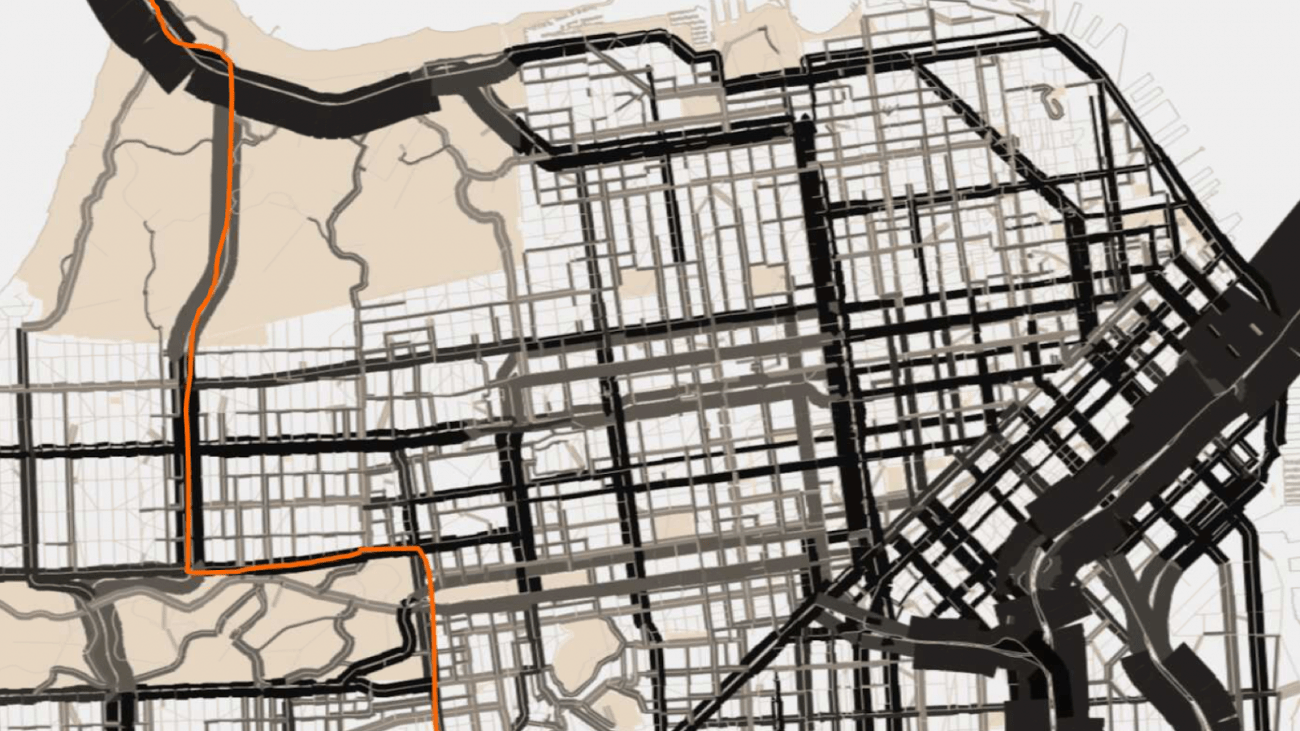
Introduction
The San Francisco Chained Activity Modeling Process, known as SF-CHAMP, is the city’s travel forecasting tool. One of several analysis tools the Transportation Authority uses , SF-CHAMP predicts future travel patterns for the city.
SF-CHAMP works by assessing the impacts of land use, socioeconomic, and transportation system changes and then forecasting how people’s travel patterns will change. SF-CHAMP was developed to reflect San Francisco’s unique transportation system and socioeconomic and land use characteristics.
ADDITIONAL SF-CHAMP DETAIL
SF-CHAMP uses San Francisco residents’ observed travel patterns, detailed representations of San Francisco’s transportation system, population and employment data, transit line boardings, roadway volumes, and the number of vehicles available to San Francisco households to produce measures relevant to transportation and land use planning. Using future year transportation, land use, and socioeconomic inputs, the model forecasts future travel demand.
Before using SF-CHAMP for forecasting travel demand, the accuracy of model results are first validated against observed data for a base year, including detailed travel survey information, traffic volumes on major facilities, and transit boardings by operator.
The SF-CHAMP Model incorporates a state of the art approach to forecasting travel demand. This activity-based model is more sensitive than traditional models to a broader array of conditions that influence travelers’ choices.
One of the fundamental differences between the San Francisco Model and traditional models is that it is tour-based, not trip-based. A tour is a chain of trips made by an individual that begins and ends at home without any intermediate stops at home, whereas a trip is a single movement from an origin to a destination. As such, the SF-CHAMP model is more complex than the traditional modeling approach.
We benefit from a wealth of basic and applied research in a wide range of fields such as travel behavior, decision science, behavioral economics, econometrics, computer science, traffic engineering, and network modeling. To the extent that we have an overlap of interests and available time, we would like to help any research projects along by sharing our perspectives and expertise as bleeding-edge practitioners, sharing models and data, and being a test-bed for applied research.
Executive Summary of original model design & development, 2002 (PDF) Model development documentation, 2002 (ZIP)
Contact
If you have something in mind that you think we would be interested in, please let us know: [email protected] .
Report: California tourism numbers top pre-pandemic levels, Bay Area numbers lag a bit behind
San francisco tourism groups say more needs to be done to bring tourism levels up to where they were before covid, by alyssa goard • published may 6, 2024 • updated on may 6, 2024 at 1:38 am.
On Sunday, California Governor Gavin Newsom posted a video of himself standing atop San Francisco's Golden Gate Bridge to highlight a new tourism report.
"So, I'm up here on the Golden Gate Bridge, a testament to America's greatness, a testament to California's greatness, the beauty, the magnificence of the San Francisco Bay," Newsom said. "What a perfect place to announce our record-breaking tourism numbers."
Watch NBC Bay Area News 📺 Streaming free 24/7
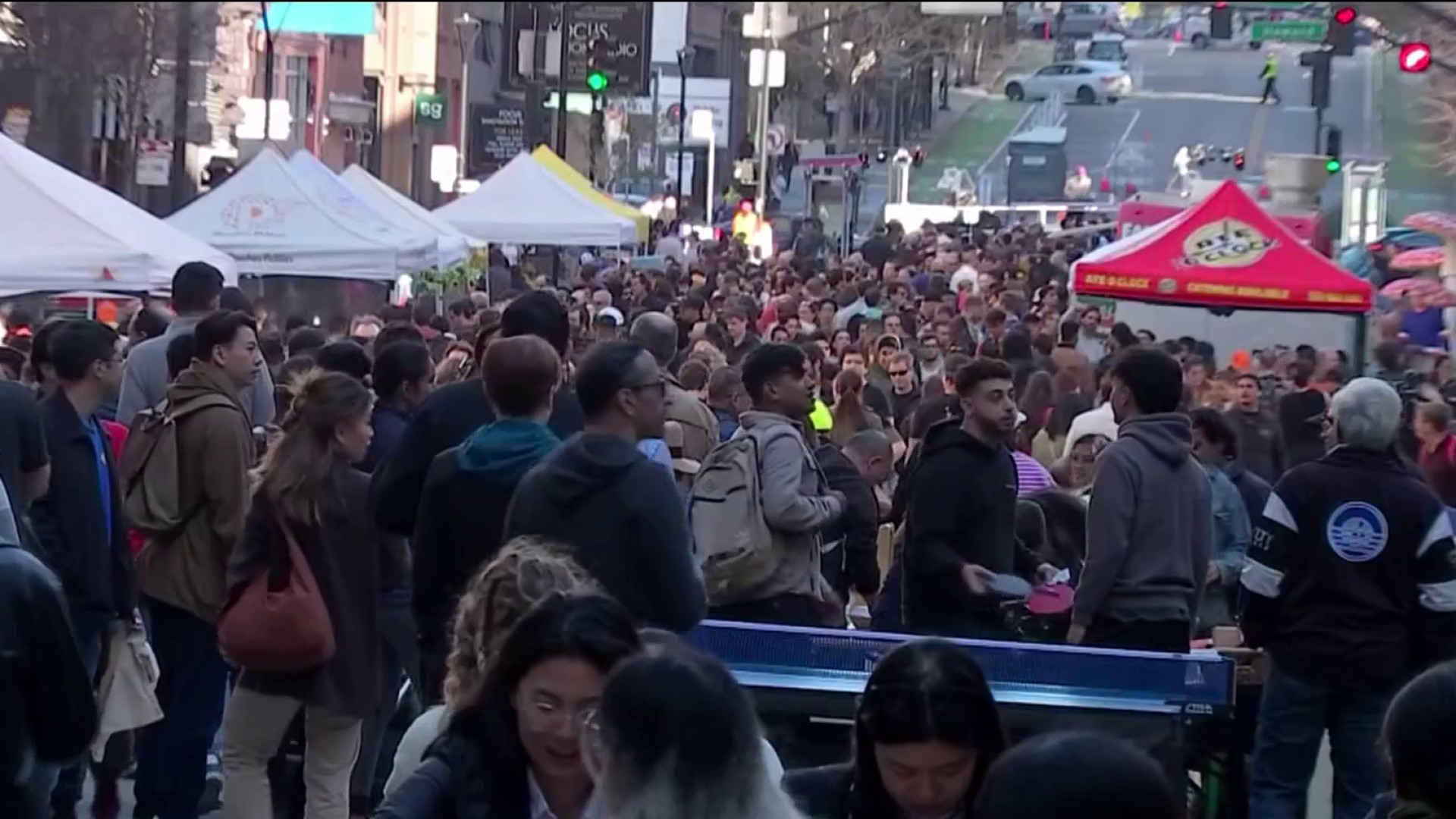
Downtown First Thursdays offers new hope to struggling SF merchants, residents
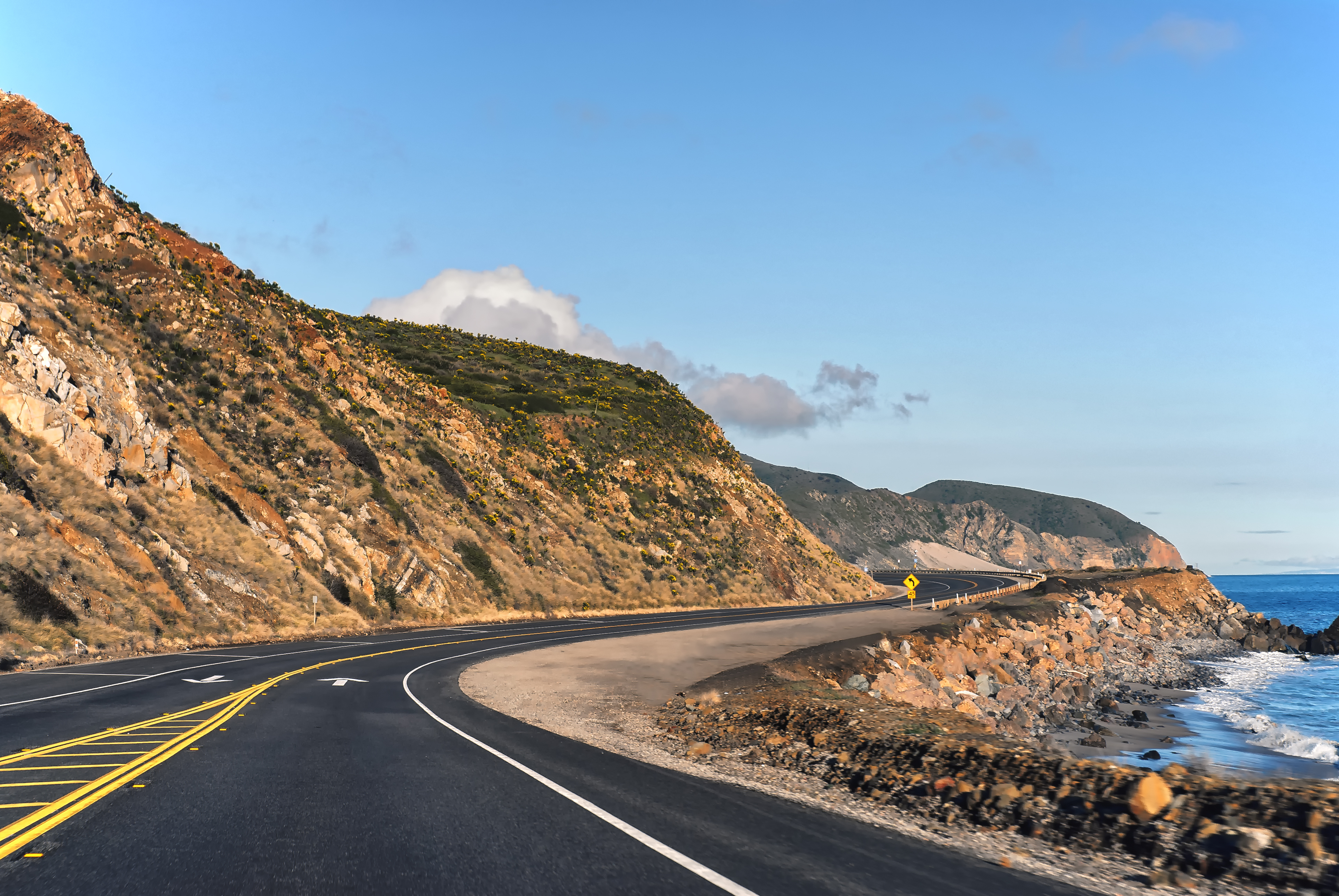
Scientists planning for future protection, adaptation of California coastline
Newsom was celebrating the new numbers from Visit California's "Economic Impact of Travel in California 2014-2023" report, which indicated that in 2023, travel spending in California reached an all-time high of $150.4 billion, a 5.6% increase from 2022.
The report also notes that California travel spending numbers have finally risen above pre-pandemic levels, with the 2023 spending level 3.8% than the 2019 spending level.
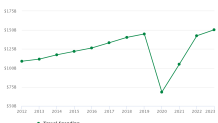
But San Franciso travel organizations acknowledge: many of these statewide gains have been driven by a surge of tourism spending in Southern California.
The report indicates that while travel spending is rising in both the Bay Area and in San Francisco County, neither has surpassed 2019 travel spending levels yet.
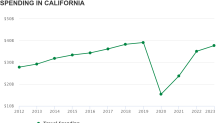
"While it is true that California is recovering and has had a wonderful, stellar year, that in Northern California, specifically in San Francisco, we still have some rebuilding to do for our visitor economy," said Scott Beck, president and CEO of San Francisco Travel.
Get a weekly recap of the latest San Francisco Bay Area housing news. Sign up for NBC Bay Area’s Housing Deconstructed newsletter.
Beck noted that travel to San Francisco from Asia has not yet returned to the levels seen prior to the pandemic.
"We have a really, really high dependence on international travel from Asia in San Francisco, it’s a very big part and an important part of our visitor mix and that is still lagging," Beck said.
Beck attributed this lag in travel to Asia to something called "lift,' meaning the volume of air travel service into the region. In particular, Beck noted that flights between the U.S. and China were halted during the pandemic. Flights between the two countries have been increasing again , but the travel numbers are not as high as they were before the pandemic.
Beck said there will be another easing of flight restrictions in June and that he expects flights between China and San Francisco to increase in the coming years.
Scott Gentner, CEO of Pier 39, explained that the breakdown of tourists visiting the city shifted during the pandemic and in the years following. Prior to COVID, Gentner said that Pier 39 got about a third of its visitors from California, a third from around the U.S., and a third from outside the country. During the start of the pandemic, international travel went away, Gentner explained.
As COVID restrictions eased in 2022 and 2023, Gentner said Pier 39 saw a resurgence of domestic visitors which has since plateaued. Last year, Gentner said the Pier began seeing more visitors from Europe and this year more visitors from Asia have been traveling in.
"There are definitely tourists here, there are definitely tourists spending," Gentner said, adding the caveat that where the tourists are spending their dollars around the city can vary.
At Pier 39, which is seeing a boost in interest recently thanks to a surge in sea lion population, sales have been doing well, with 2023 sales on par with 2019 sales, according to Gentner.
"We have a record number of sea lions, it's something we didn’t know was coming and it's certainly bringing a more local crowd to Pier 39 and rediscovering some of the great things we have to offer," Gentner said.
At nearby Fisherman's Wharf, the executive director of the Fisherman's Wharf Community Benefit District, Randall Scott, said that the pedestrian count there is down 18-20 percent from pre-pandemic levels.
"We’re on the way to making it back to where we were," Scott said, noting that hotel rates and occupancy rates are still down compared to 2019 in the area.
"We’re doing OK, compared to the rest of the city -- I would argue that our numbers are very good -- but compared to the rest of California, we’re still significantly down from where they were in 2019," Scott continued.
To help close the gap, Scott would like to see investment at the state and federal levels to help showcase the area and promote the message that San Francisco is a safe and exciting place to travel to.
Scott had one message in particular for California's governor:
"Governor Newsom: thank you, thank you, thank you for bringing tourism back to California. Southern California posted those numbers, please bring back and help us bring back the tourist industry to San Francisco," he said.
This article tagged under:

Wolf Street
Anatomy of san francisco now: fewer people, jobs, tourists, & businesses, but more spending by the hangers-on (but that was inflation), by wolf richter • jun 27, 2021 • 162 comments, the recovery as it were, after everything went to heck but didn’t., by wolf richter for wolf street ..
San Francisco is one of the most touristy cities in the US – both for leisure and for business – and it is also a tech and social-media center, a startup Petri dish, and the epicenter of working from home. During the Pandemic, the city has lost large chunk of jobs and a significant number of its residents. So here is an anatomy of the San Francisco economy where it currently stands, based on a report by the City of San Francisco’s Office of Economic Analysis and based on some data from other sources that I added to the mix.
Despite the loss of jobs and population, the remaining residents in the city are doing what they’re supposed to do as good consumers: They’re spending money. By May, credit card spending had fully recovered and was up 5% from the pre-Covid baseline in January 2020, according to credit card spending data, seasonally adjusted (Chart via the Office of Economic Analysis, citing data from the nonprofit Opportunity Insights and Affinity):
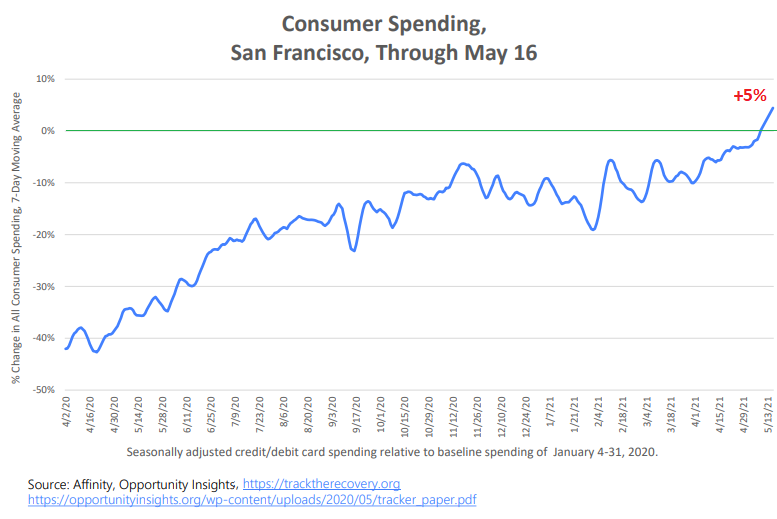
So locals spent 5% more with their credit cards than they did before the pandemic – and this was just inflation since CPI jumped 5% year-over-year in May . And they’re spending less in brick-and-mortar retail stores, many of which remain shuttered, and more online, and they’re also spending at restaurants and other leisure activities.
Small businesses: restaurants v. brick-and-mortar retail.
There is now a thriving restaurant scene. Indoor dining is back, and now there are about 1,500 “parklets” where restaurants have created outside-dining areas on curbside parking spots, wide sidewalks, back patios, and public areas. Some restaurant streets are closed to traffic at night, and there have never been so many people visible on the street, milling around and sitting around in these parklets, as now. The whole ambiance has changed.
Restaurants with parklets now have more tables than they did before they built the parklets, and they can accommodate more business than before. And all kinds of new restaurants have sprung up.
But brick and mortar retail stores are in deep trouble. The sight of shuttered stores and “for lease” signs are everywhere. Nail salons and other services-based businesses are sprouting, but brick-and-mortar retail was already in trouble before the Pandemic, and so many stores were vacant and forming a blight that the city imposed a vacancy tax to incentivize landlords to find tenants.
As of June 2, 43% of San Francisco’s small businesses remain closed, compared to the already beaten down baseline of January 2020 (green line), based on payment and payroll data from Opportunity Insights, cited by the City’s report.
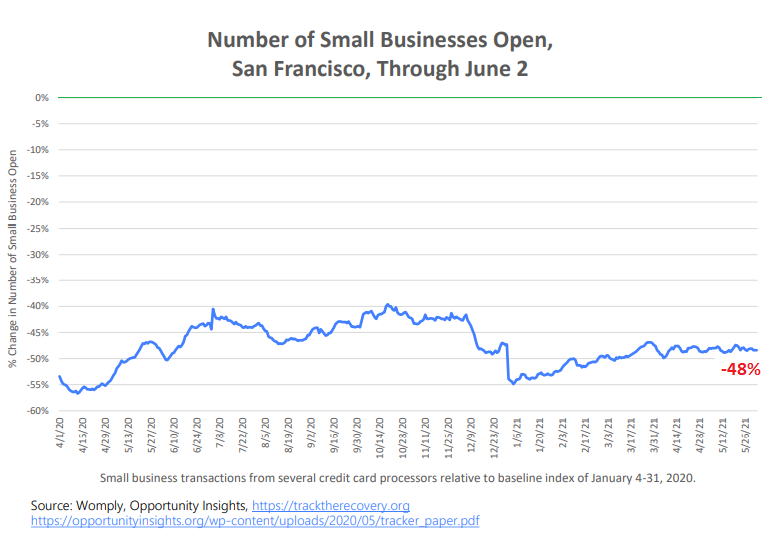
Working from home and not going to the office.
Working from home is huge in the San Francisco metro, and office attendance is still minuscule. According to data from Kastle, which provides electronic access systems for office buildings, office attendance as measured by people entering offices in the five-county San Francisco metro (red line) was at 18% of the level in January 2020, meaning office attendance was still down 82%, but creeping up. For comparison, in Austin, TX (blue line), attendance is at about half the level compared to January 2020.
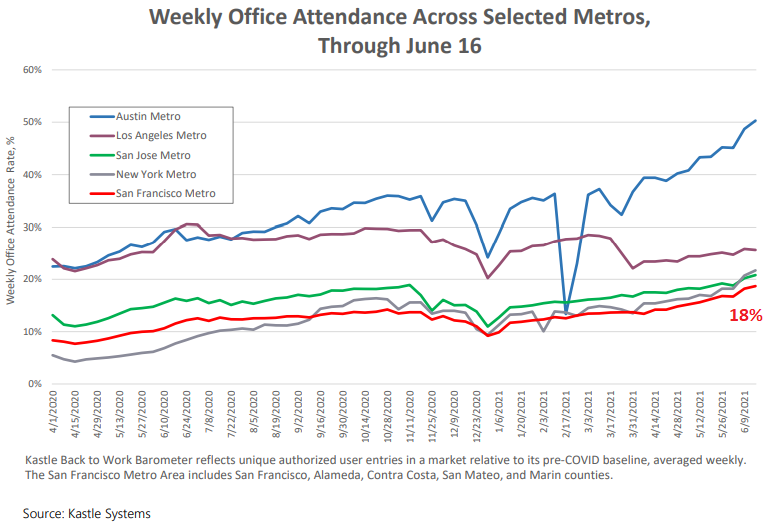
Employment plunged, then recovered only some.
The number of residents in San Francisco who are working took a massive dive in April 2020 and has only partially recovered. In May, the number of working people was still down by 9.5%, or by 54,500 people, from February 2020, according to data from the California Employment Development Department (EDD). And as we’ll see in a moment, some of those people have left San Francisco:
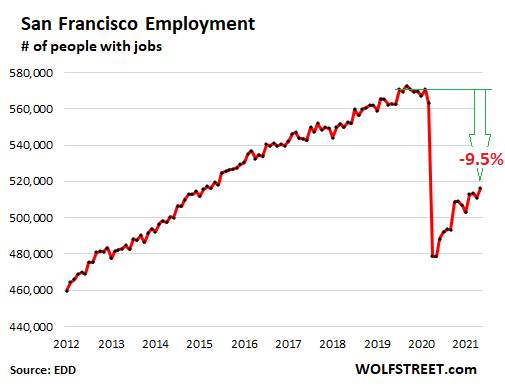
The leavers and the stayers .
In early May, the California Department of Finance released its annual population estimate. By the end of 2020, the state of California had lost 182,000 people compared to a year earlier , the first population loss since the data had been tracked. San Francisco lost 14,800 people or 1.7% of its population (red column), now down to 875,000 (red line), the lowest since 2015:
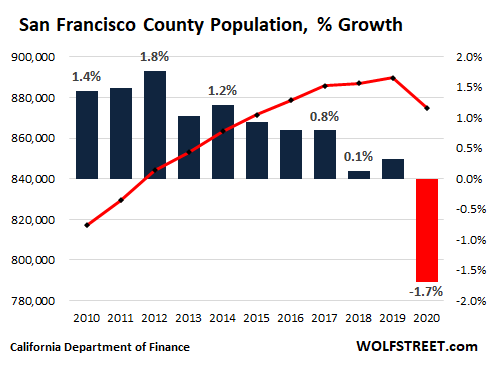
But road traffic out the wazoo again.
Traffic across the Golden Gate Bridge into San Francisco in May was down only 15% from the 2019 average. Traffic congestion on the freeways is back, and average speeds have slowed to pre-Covid averages of 31 mph, down from 60 mph in March and early April 2020. Lots of people are driving who had been taking mass-transit. And plenty of tourists from other parts of California or the US are driving into San Francisco. The weekend congestion is back. We live on a busy street, and it’s busy as heck, especially on weekends:
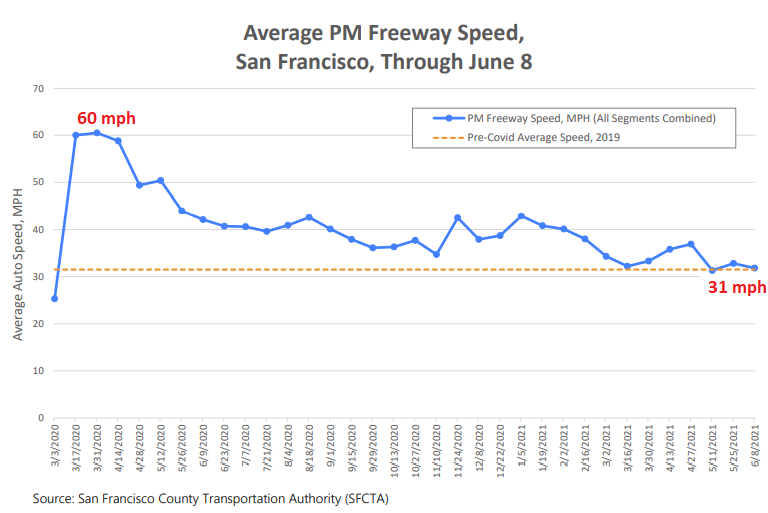
But almost no one is taking mass transit.
The Cable Cars are still shut down. Buses and streetcar lines operate at reduced levels. Ridership on the Bay Area Rapid Transit (BART) system, the train system that links the East Bay to San Francisco and Silicon Valley, was still down 84% in May from May 2019. When people do go to work, they’re driving:
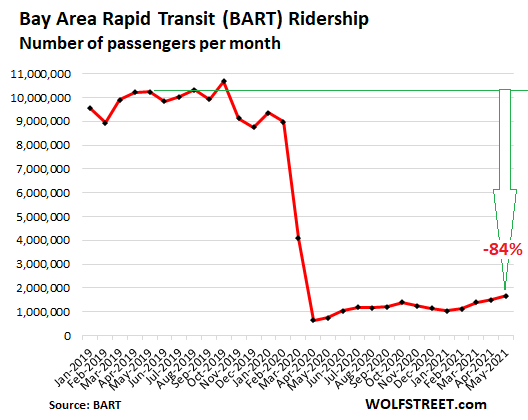
Time spent outside the home despite working from home .
Despite the prevalence of working from home for office workers, and the near ghost-town atmosphere of the Financial District — though it’s much less so now than last August when I documented the ghost town Financial District with photos — many businesses are open and require workers to be there, from restaurants and repair shops to construction sites.
In addition, locals have discovered the beauty of outdoor areas, the parks and shore line while tourists were largely gone. I have never seen so many people swim in the Bay while pools were closed. Locals were doing lots of stuff and getting out. But many of them were just not going to work, but were working at home or were not working at all. Now the swim teams have returned to heated pools. But people are still not going to the office (chart via the Office of Economic Analysis, based on data from Google Mobility and Opportunity Insights):
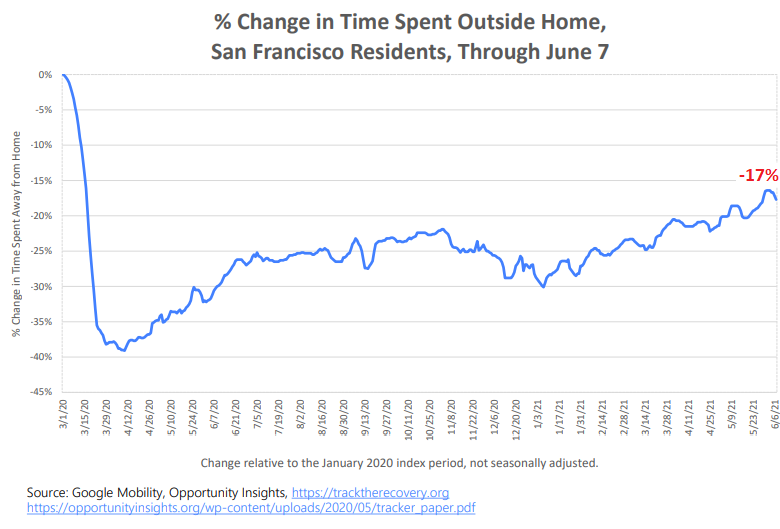
International tourism and business tourism are still dead .
Tourism, a huge industry in San Francisco, is still way down. The crucial tourism from Asia is still dead, and business tourism is also still dead. But domestic tourism is thriving, and these people drive from other places in California and from other states into San Francisco, as demonstrated by the traffic jams on weekends. But far fewer people are flying in.
According to data from the San Francisco International Airport, the number of people getting on a plane in April – such as business and leisure tourists going home, and locals heading out – was still at 31% from the 2019 average. Part of this is the collapse in traffic between San Francisco and Asia (chart via the Office of Economic Analysis):
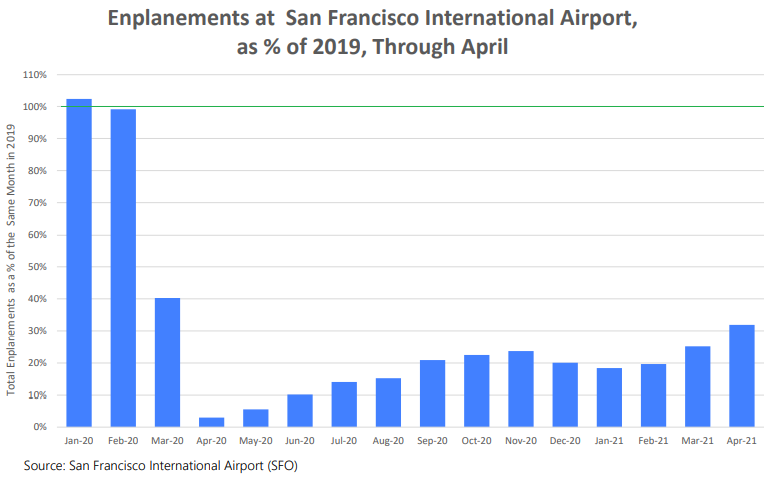
Hotels reopened, and some folks are showing up .
The average daily room rate has risen to $160 per night. But that’s only about half the average rate in 2019 of around $319 a night.
And hotel occupancy, which in 2019 averaged around 79%, was still only 35% in May. This is figured of total room inventory (TRI), which counts all hotel rooms whether or not the hotel had re-opened (chart via the Office of Economic Analysis):
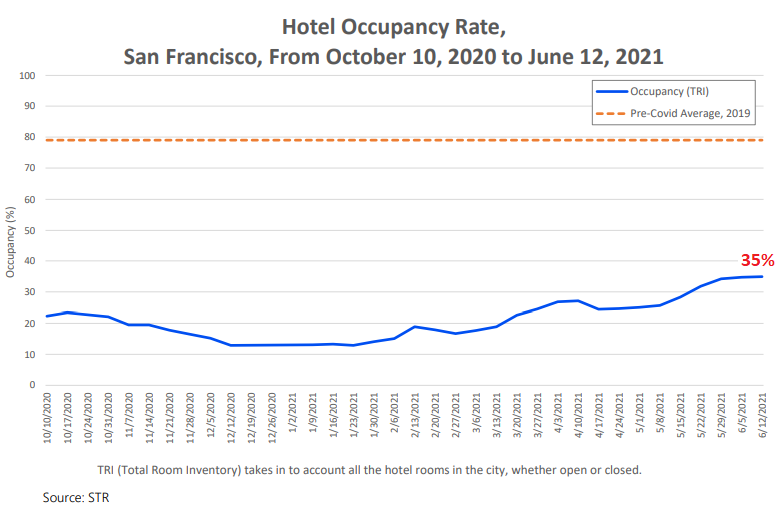
Asking rents plunged 30%, and now there’s price discovery .
So there are fewer people living in San Francisco and fewer people have jobs, and apartment vacancy rates are high, and there is a huge amount of churn, with tenants trying to get better deals and nicer apartments. This has been going on for over a year.
In June, the median asking rent for one-bedroom apartments was $2,790, according to Zumper, down 25% from July 2019, after having been down as much as 30%.
But these are asking rents. They’re a way for landlords to find out what the market will bear. If the unit sits vacant long enough, they’ll drop the asking rent or offer other inducements, such as two months free. Asking rents are not actual rents or effective rents. They’re advertised rents; they’re the rents at which a landlord is trying to make a deal; they’re a form of price discovery, and in uncertain times like these, they can be all over the place .
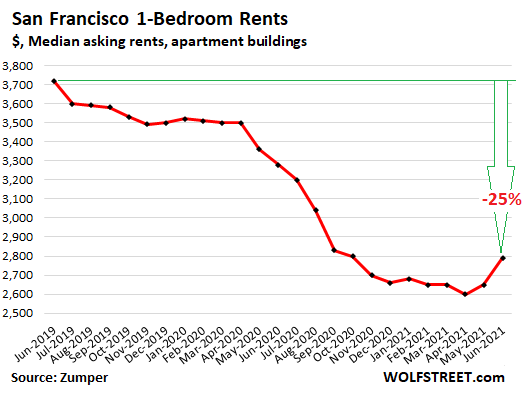
So this is the economy of San Francisco. Fewer residents, fewer tourists, fewer jobs, fewer businesses, a still dead Financial District, lower rents, lower hotel room rates, near-empty BART trains, and lots of closed stores, but busy restaurants and lots of spending by the people that hung on.
Enjoy reading WOLF STREET and want to support it? You can donate. I appreciate it immensely. Click on the beer and iced-tea mug to find out how:

Would you like to be notified via email when WOLF STREET publishes a new article? Sign up here .
162 comments for “ Anatomy of San Francisco Now: Fewer People, Jobs, Tourists, & Businesses, But More Spending by the Hangers-on (But that Was Inflation) ”
I was on SF in mid May. I have never seen people so happy to be outside. I went to breakfast with my daughter the first day and people were sitting outside wearing wool hats and parkas. Some were wrapped in blankets, but doggone it! – they were OUT!
And there was the guilty pleasure of having the city to yourself without tourists everywhere, knowing that you needed them back.
I was visiting from my adopted country, Texas. We had already been pardoned by the governor much earlier. Not that we took it seriously anyway – barbecues were automatic social distancing. No one can catch covid from smoking a brisket or by eating it. You could also socially distance by going to your hunting lease. You could even pretend to be in SF by sitting in your hunting stand at 6 am freezing your butt off and enjoying the lack of tourists. And it has always been difficult getting too close while wearing those big hats.
There was also an air of uncertainty in SF. The rules didn’t seem to be clear. People wearing masks and people not wearing masks would sort of covertly eye each other wondering who was wrong. Kind of like when you’re driving in a light rain and checking to see who had their wipers on or not. You don’t want to be the only person doing either.
Then there was the fukitol crowd. No masks, let’s shake hands, we’re spike protein factories now, hear us roar! Let’s eat outside – it’s almost 55 degrees. You can borrow my blanket.
Michael Gorback
“People wearing masks and people not wearing masks would sort of covertly eye each other wondering who was wrong.”
Interesting question ??
I suppose the only answer to that is to ask if a virologist working on a semi-nasty virus would work on it wearing a simple cloth or paper mask. You could also ask, if you were working on a semi-nasty virus, would you trust a paper mask to protect you. If your anwer is no to both questions or even one, then you know who was right.
Well, I am an immunologist with thousands of hours of BSL3 time working on live viruses, and frankly, your straw man false equivalency is tiresome. Too tiresome for me to even dissect at this point of what has been a tiresome 18 months of uninformed people spouting uninformed opinions. So, I’m just gonna go do something productive now rather than getting into this again.
Rather than having a patronising hissy fit, why not let us know in a very few words your expert opinion?
Are commonplace masks worth it or not, indoors and out?
A friend who is also in immunology, and actually rather distinguished (Cambridge University) has given me his considered opinion, and I for one would value yours.
Xabier. So what did your friend say? To throw your question back at you.
I have used respiratory protection for chemicals and trained people on that for decades in my humble occupation.
If one searches, there are examples of engineering labs that have been publishing data for decades on the subject of respiratory protection in chemical and medical applications.
As usual, anecdotal info is used to counter quantitative data. No piece of gear is perfect partially because people using it are not perfect. Example- you can have the best mask, and if you contaminate it, you will not get protection.
Masks help, and the procedures for using varies. An “engineered/designed” mask is optimized for exclusion of contaminants and enough flow for intended purpose. If you use two of those you will not succeed because of air flow problems. If you use a piece of cloth, you can use two and get enough flow, etc.
What is called a “fitted medical mask” is supposed to be the best against viruses. There are youtube videos of medical specialists talking about these.
One has to want to know and make the effort to search for the info. You will not get it in the popular media.
No one got the flu.
Hahaha! It was driving me crazy and I figured with dropping the mask requirements I’d heard the last of it, along with “You can’t force someone to wear a mask”, “You can’t force someone to get vaccinated”, and “I wore a mask and got covid anyway”.
But yeah they can force you to get vaccinated since the Supreme Court ruling in 1905. And if you think nobody can make you wear a mask try not wearing your seat belt.
Common Anthony, you have an axe to grind, we get it. But there is credible evidence that masks can help reduce the spread of an airborne virus.
Face masks effectively limit the probability of SARS-CoV-2 transmission Science 25 Jun 2021: Vol. 372, Issue 6549, pp. 1439-1443 DOI: 10.1126/science.abg6296
This discussion is BS. San Francisco has had the lowest, or one of the lowest, infection rates of any major city in the US though it was among the first cities to get the virus. Prevention measures, including broad adherence to mask rules, saved lots of lives.
Michael Gorback, a doctor, understands the importance of masks, though YOU might not.
What he was talking about was that in May, mask requirements were being lifted for fully vaccinated people. And many people continued to wear masks because it’s free and doesn’t hurt and can save lives. What’s your problem with that???
Totally agree: masks save lives. There is also a lot of information online about which masks are most protective. It’s been possible to get N95s for quite a while.
Separately, there was a good Ars Technica article explaining the CDC’s perplexing May statement about masks: not based on science; rather, the CDC was trying to manipulate the non-vaccinated into getting the vaccine. Good luck reinstating the mandate .
We saved a lot of lives here in Montgomery County, MD. We are the lowest in the country. We beat SF. People acted responsibly for the most part. Now its time to get back to work and get the kids back to school.
Masks help, but are not perfect, like most things in life. It’s like taxing the extemely wealthy to make them pay their share. Sure, it would not solve the deficit, but it sure would help. Straw man argument it was.
It’s hard to believe this kind of argument still exists.
Masks, unless N95, are NOT for your personal protection. They are to protect others from large droplets that are spewed by the person wearing the mask.
That’s why (well, one of the reasons why) people are angry at Fauci. At one point he told people not to bother with masks since they were not protective. Later on he pushed for masks, but for the reason cited above: they block transmission from the wearer.
So your mask protects me and my mask protects you.
Fauci- for those of us in the SF area during the AIDS outbreak, he is a famous MD. I started last year by telling people to listen to him.
He messed up the communication so many times, has emails about wanting to create super-viruses, insisted on funding the lab, and wants to make money on a tell-all book.
He really messed this up. Now I ignore Fauci.
That’s not why Fauci initially told people not to wear masks. He told people that because there was a critical shortage and healthcare workers needed priority. Fauci should have been honest and told the public to make their own until the shortage was addressed. Instead, he elicited mistrust and confusion.
Hei guys, don’t question St. Fauci, because if you do, you are questioning SCIENCE!!!
We’re about a year and half into the pandemic and these notions still persist. It’s incredible to say the least.
Masks don’t protect the wearer. They protect the others from you especially if you are infected with Covid. If you know you are sick with Covid or with the flu, what the hell are you doing out in the public infecting other people. Stats show that 80% of the people that got Covid were wearing masks at the place of infection. END OF STORY.
P100 half mask respirators are likely close to 100% effective against covid and variants. I have used them for years in industry to protect my lungs. They are affordable – about $50 – and reusable almost indefinitely in low particulate environments. Should have been mass produced and deployed everywhere in confined spaces. Would have stopped the pandemic.
“I suppose the only answer to that is to ask if a virologist working on a semi-nasty virus would work on it wearing a simple cloth or paper mask. ”
Paper masks are good for blocking sneezes but they won’t protect you from the virus. Most people have little education in the sciences and can’t comprehend what’s happening at the molecular level. Unfortunately our government is now capitalizing on this ignorance to get people out of masks and shopping again.
Viruses mutate and we know that you can still carry the virus even if you’re vaccinated. So the only true way to get rid of this thing with the current crop of vaccines is to wear masks. My guess is that that our corporate masters want to make this a long emergency that keeps people in constant fear and dependent on the government for their next dose of vaccine (what all drug dealers do).
Still, I don’t know how San Fran will keep going with 43% of all small businesses closed. Sounds bleak.
Vaccinated people are unlikely to transmit covid. What is called sterile immunity is rare. If you have polio vaccination you are safe gut you can still carry the virus in your gut.
Even in largely vaccinated populations, dropping vaccination rates can cause resurgence, as we saw with measles in 2019. Thanks NYC!
The best measure for covid is to just go ahead and ride the needle.
May data show that there were 853,000 covid related hospital admissions, of which 0.1% were in vaccinated people. 99.9% were not vaccinated.
More than 18,000 COVID-19 deaths in May, of which 0.8% were vaccinated. 99.2% non-vaccinated.
Can it get any clearer? Get vaccinated. Masks and social distancing are nothing compared to vaccination.
@Michael Gorback
You missed the point. We’re trying to kill off the old strains and prevent the evolution of new strains. Only a combination of masks and vaccination can do that. You are also assuming that these COVID vaccines are on par with the polio vaccine which lasts for many years. Most experts stress the current crop of of vaccines will only likely last 6-9 months, but that is still up in the air.
Right now the authorities are holding back the most promising vaccine we have -the Novavax vaccine. Good masks always work against all current and future variants!
P.S- “The World Health Organization (WHO) Friday recommended continued COVID-19 safety protocols even for fully vaccinated people, due to the continued rise of the highly transmissible delta variant.”
There is no way short of the sun going supernova of “getting rid of this thing” as it is now ENdemic. The virus exists, like the bacterial bubonic plague, and it will mutate and pop up occasionally and kill a few people. We, the arrogant species we are, think we can get rid of it. We have to accept and deal with it.
Bobby Dale- A very refreshing statement, “We, the arrogant species that we are..” Thanks. Most of the commenters on the Covid Subject here ARE arrogant, (especially those that hold various levels of “knowledge tickets” in the Medical Industrial Complex) in that they did NOT learn they understand very VERY LITTLE about a 4.5 billion year chemical game. Still, a ticket entitles them to speak like they do, and make more money. Here is one of my favorite virus articles, only the first section needs to be read. https://pubmed.ncbi.nlm.nih.gov/30250470/ If saying all this makes me arrogant, and it likely does, I admit to it. I also admit to having hated parts of this culture someone else invented and stuck in my brain for most of my life. But I do like and value my body, even my brain, to the extent that it has allowed me to keep questioning, exploring, and learning and UN-learning as I finish out my 83 years of existing, or whatever it ends up being.
Oh yeah. I WILL wear an N-95 every time I leave my apt (except when driving) for the next 2+ years if people keep dying from it, even though I’m pretty certain I have had it, and hope the blood test I get next time I see the Doc is (accurate) confirmation. I also totally believe in GOOD science and GOOD scientists e.g., curiosity driven, not money driven.
“Paper masks”
You make it sound like a pejorative. But there are several types of common and well understood filter materials, including a randomly layered mat of fibers (what you called “paper”).
The air filter in your car a “paper” filter.
For the past 15 years, we have used two big HEPA (high-efficiency particulate absorbing) filters at home to filter out allergens, and they work wonderfully. HEPA filters filter out virus as well, including Covid. And they’re “paper” filters = a mat of randomly layered fibers.
The randomly layered fibers as filter material has been well understood for many decades. They are usually made of polypropylene or fiberglass (air conditioner filters), and they come in all kinds of designs and for all kinds of applications.
You can design these filters to filter out smaller particulates, in which case they’re harder for air to pass through. So for filters that you put over your breathing apparatus, you have to make compromises so you can breathe. N95 is about all you can breathe through.
An N95 is also a “paper” filter, but inferior to a HEPA. But a HEPA filter is too hard to breathe through, unless you have a large filter surface, which makes it awkward for a face mask.
Wolf, you’re right on being a stickler for words, but as a person with a scientific background I say what I mean. Paper (being nothing more than cellulose based fibers), is vastly inferior to the melt-blown polypropylene fibers found in n-95 masks and HEPA filters. Yes, HEPA, is often made from mats of synthetic polypropylene fibers with the noted exception many of these synthetic materials can maintain an electric charge so as to better attract particles.
Paper does not mean “a mat of randomly layered fibers.” In fact paper is not really a scientific term but a broad description of many types of cellulose based materials. You would never really use that term in a published article, except in the widest sense.
I have nothing against paper anything, and I’d make masks out of Broccoli if I thought it could block COVID. Just used ‘paper mask’ as an example of a cheap, marginally useful type of mask.
Since I “damned” the Medical Industrial Complex, here is a good example of the crapp that goes on at the hospital/insurance part of the whole biz.
https://khn.org/news/article/surprise-bill-iv-push-hospital-unbundling/
This has nothing to do with Kaiser, the HMO. It is funded by the Kaiser family (who were just into making steel and things out of steel) but nonetheless had a part in starting “Managed Health Care”, which (like everything else) is ALWAYS best done by the more “efficient” Private Industry, as every pre-programmed government bureaucracy hater knows and says as much whenever possible.
Incidentally, a hospital’s billing codes are proprietary (considered part of management’s “managing secrets”). We need single payer like the rest of the developed world, healthcare is a RIGHT…..even if it is at present largely full of money making “for profit science”.
But they still can help out a lot of people, just not anywhere close to as many as they claim they can.
What we really need is for a few thousand of these hospital administrators, and the decision makers at the PE firms that own these hospitals, to get sent to hoosegow for a few years or more. The RICO Act or other laws should be applicable here.
I agree. But I bet enough laws have been lobbied thru by these criminals that any DA would find prosecution prohibitively expensive if not downright impossible, not to mention gutting of his and all other “wasteful” government resources.
See GFC aftermath, only one major player was prosecuted and he turned himself in.
Are you an epidemiologist?
If not, I’ll just file your “opinion” where it belongs…in the garbage.
Nice piece of trivia. According to online articles San Francisco is cold. They’d be warm, if they were in LA.
“I was visiting from my adopted country, Texas. ”
So when does Texas go back to being it’s own country? maybe all those Californians in Austin will move back to California. Then I’m ready to move down.
Come move next February when the temps are below 0 and there is no electricity.
So you are saying the Californians brought their brownouts with them?
Hopefully soon. Then we can have our own internet and money. LOL!
To paraphrase the Reeses commercials, “Keep your California out of my Texas”.
Austin was already like California. The immigration has only made it worse. The last thing I’d want here is California style voting and policies.
Don’t put it past Texas to build its own wall – around Austin.
I like watching those doofus buffoons strutting around in their 10 gallon cowboy hats. Cracks me up every time. Imagine…grown ass men walking around making total jackasses of themselves!
Like George Carlin said “It’s not even Halloween. The closest “Tex” ever got to a steer is when stopped to to take a crap at an Arbys.”
Watch the next hurricane that hits Houston. All those anti-govt “Don’t mess w/Texas” crybaby snowflakes will be wailing: “Where’s FEMA?!?! FEMA come help us!!!!”
The best hypocrites you can find….
nodecentrepublicansleft, if Texas is such a bad place, explain to me why all the California residents are relocating there?
“explain to me why all the California residents are relocating there?”
Not all. There are still a couple of us fossils hanging on here, holding down the fort. 39 million, to be more precise :-]
Yeah, I’ll try to suffer it out here, too.
BTW, the only thing I can think of offhand that is nicer about Texas (I’ve driven around most of it) is that when oncoming traffic sees you are speeding, they flash their lights to let you know they passed a cop hiding behind a billboard or something to warn you. Last time thru was late 70’s, so I don’t know if it’s still done there.
Although now that I’m thinking about it, it seems kinda odd for a “law and order” State.
Oh my, Michael, you are in danger…. These are all potential superspreader events, all these unmasked in TX are going to make you sick. Hope you are at least vaccinated, although the efficacy against the D and D+ variant is really TBD. And what happens when there is a further mutation.
I love your ‘little story’ ? We the people, when we are good, we are magnificent.
“we’re spike protein factories now”
Why isn’t someone selling that as a T-shirt in Union Sq. or Fisherman’s Wharf?
Or a BEER MUG?
Somehow Nixon’s declaration in 1971 that we’re all Keynesians now didn’t make it to a T-shirt either.
If Martin Luther were alive today, do you think he’d nail 99 T-shirts to the church door?
Please state any evidence that these mRNA injections are doing anything at all to genes. I would love to see it.
Wait, how did San Francisco experience the stimmies fueled inflation? Most folks out there (particularly the ones I know), didn’t qualify for any of those fresh greenbacks. Most of the folks in the city are part of the 6 and 7 figure crowd, didn’t lose their jobs, and didn’t receive all that free unemployment payouts. And considering most folks in the city have pets, rather than children, I can’t imagine the child tax allowance suddenly pumping in the money.
But strange, maybe it was all pent up demand. Maybe folks were saving money during the quarantine. Maybe following a blitzkrieg vaccination push, all the money was literally rushing for the exit door. Maybe, even without stimmy money.
If only we could find a counter-factual, looking for a country (Canada) (Australia) or an economic bloc (EU) that still gave out mad amounts of social program money, didn’t blast everyone with vaccine in a matter of weeks, and then douse businesses with unrestrained demand.
In theory, business owners could have kept prices low, just to make sure these contrived charts didn’t jitter. But I guess we can’t shame the people with actual power for price gouging when the opportunity arrives. Let’s talk about “buyer’s strikes” instead, as if they were collectively organizing a civil rights campaign.
“Most folks out there (particularly the ones I know), didn’t qualify for any of those fresh greenbacks.” Yes, there are quite a few people here who didn’t qualify. But LOTS of people who DID qualify. Median household income is $112,000. Median per capita income is $68,000. Meaning half of the households and people made less than those median income figures.
Plus, lots of people got forgivable PPP loans, given the importance here of contract work (coding, engineers, etc.), startups, small businesses (such as law firms), etc. I looked at the SBA’s list of PPP loans by zip code. And it’s amazing how many PPP loans there were by zip code. That too was stimulus money, but for a lot of these people it was serious money, 10s of thousands or 100s of thousands of dollars. That’s where the real stimulus money was.
I suspect some of the recovery was due to stimulus money in one form or another.
If you look at net national savings we haven’t had a recovery. We have been trending down from more than 10% to around 2% with multi-year trend still down. If you save $10K and govt borrows $10K then national savings is zero. You need savings to increase long term standard of living.
I still say we are under an illusion of recovery as it is fueled by government policy of debt. We probably would have been better off to have had limited and targeted spending on those who really were affected by covid instead of blanket money spraying all around. Now demand is too hot for supply so prices going up.
Government had no good ways to inject money into the system before this event. Government struggled for how to get money funded to small to medium business and that program was PPP. Was involved with the regional banking system as that was setup. It was changing on the hour by the minute as we deployed this. We now have ways and methods for money to get out to small to medium businesses that didn’t exist. This fundamentally changed and built a framework for future money deployments in mass
1) Dr Faust : keep America comatose until we know what we don’t know. 2) But what if the patient will not wake up. And what about the brain damage. 3) SF number of small business open : (-) 52%. 4) NYC office attendance : (-) 80%. 5) International business travel : (-) 90% 6) BART ridership : (-) 84%. Parking lots are thriving in sunny summer days near SF Bay. 7) Adjust to @ 5% inflation, 1BR rent : (-) 40%. Since apartment prices stayed about the same vs houses, 1BD yield : ($3,800 x 0.60 x 12M)/ $1M(?) < 3%, better than the stock markets.
An economy in a forced coma, probably waking up to find itself partly brain-damaged.
Sounds not at all unlikely.
That whole sectors of the economy will have to be eliminated anyway to to the growing energy/resources crisis, and others rapidly digitised to meet other strategic aims, perhaps makes the putting into a coma condition easier to understand……
I like the New York City layout. It is basically a series of small towns populated by many small businesses, surrounding large corporate facilities, like Wall Street and its environs. You got big, but you also got neighborhoods. Is that layout now irrelevant? I am skeptical that suddenly the entire world changed fundamentally. There’s a lot of churning going on, which is understandable. But I doubt that it is permanent.
I wonder if 43% of small businesses in New York City are still closed, like with San Fran. Does anyone know?
I’ve been avoiding the place like the plague. (Ha Ha)
What do you think will happen when the fires start up again? There seems to be a stumbling recovery in some sectors right now, but choking smoke and rolling blackouts look to be an ongoing trend.
This is from someone living in the current heatwave in BC, although it looks like it will begin to break for us this evening with a return of strong westerlies. (Around 99-102F for the last 4 days). I live on a decent size river and it has been so hot not one kayaker has been sighted for days. Tourists? staying indoors at home it looks like. I mention this because summer tourism to CA might become thing of the past going forward. The Pacific moderates the temp, and onshore breezes may keep the smoke inland, but last year’s pics are etched pretty deep.
The heat wave in the PNW adds a new twist to WFH. Lots of people who are stuck in un-airconditioned or poorly cooled houses and apartments are flooding back to the office today ( if the roads are any indication) for the commercial quality AC. My building is filled with young Intel employees and our Ac situation is not up to the 112 degree temps. I am looking out the window as I write this and people with name badges are jumping in their cars and heading out like it was morning rush hour in 1999.
Why are there people living in “un-air-conditioned” houses? They cost about $125.
Sorta ironic to me. I spent the unusually cold winter of 78-79 in Corvallis. People didn’t know how to drive on ice and snow. (Luckily my jump buddy was from Iowa when we went to Sheridan). Crashing closed bridges over the Columbia several times, and body shops had 3-5 weeks+ waiting lists. You could even fall on your ass walking to class if you didn’t pay 100% attention…pretty girls got a kick out of it. I got to “see” my only total solar eclipse, too….around 9am but plenty low depressing dark clouds as usual. Birds went NUTS.
1) A SF small business owner insured his safe, protected properly with alarms, for $10M. 2) The landlord finally evicted the owner after a prolong non-payment. 3) A safe co crew opened the large Empty safe, detached the heavy door, load them separately into the service elevator to the street, until the safe co truck picked them up. 4) After several years of law suits, the landlord will have another crack in his sinking building, if the landlord wasn’t careful, saving money. 5)He didn’t know what he couldn’t know that it was a professional setup.
And the City’s budget?
Even after the massive bailouts?
“So this is the economy of San Francisco. Fewer residents, fewer tourists, fewer jobs, fewer businesses, a still dead Financial District, lower rents, lower hotel room rates, near-empty BART trains, and lots of closed stores, but busy restaurants and lots of spending by the people that hung on.”
California in general is incredibly dependent on the stock market and capital gains, which have been booming. And now California is awash in cash. Looks like San Francisco will end up with a surplus in the current fiscal year.
But yes, the budget is around $13 billion, and it keeps growing. On a per-capita basis, this has got to be the highest in the Universe.
Well, I have heard now is a great time to use the rainy day fund in CA to support a lot of these programs that has been put forth. How much of a hole in the budget do we think is going to be there as Gavin tries to stave off the recall by telling landlords they will be made whole.
Technically, this is federal money, so may be it isn’t part of the state budget, or at least not derived from the state income taxes.
Right now, Sacramento is floating in money. They’ve got so much extra money that they’re working hard trying to figure out how to spend it. They could replenish the Rainy Day fund or pay down debt, but that’s not going to happen.
I have three words for that, Wolf, High Speed Rail.
Meets all of the criteria, green, check, union jobs, check, shovel ready, check…. Ok, only kidding about the last three.
No one can ever build a high-speed rail system to connect San Francisco and LA because it would have to go through some very expensive neighborhoods at both ends, and they have totally blocked that. The only thing they can do is build it in the Central Valley, from Fresno to Bakersfield. And that’s what they’re doing. The rest cannot be done.
Heheh, you and I both know that… well, ok, I only know about it for the north end since no one in Palo Alto, Atherton, and Menlo Park would tolerate the noise. Don’t know anything about the south side.
But if they throw enough money and lawyers at the problem, eventually it can be done…
So, in the end, the green dreams of mass transit to connect large cities have been foiled once again by the rich, at the expense of the “working class.” That sounds like it could be a good political slogan if the politicians weren’t so indebted to those same expensive neighborhoods for donations.
The solution though is obvious, just move the working class out to Bakersfield and Fresno. Mass transit dream achieved.
“so many stores were vacant and forming a blight that the city imposed a vacancy tax to incentivize landlords to find tenants.”
Fascinating! I don’t what else to say.
I’ll bet the landlords were just thrilled about this…..as if it’s their fault.
Wouldn’t go to SF if you paid me.
Good to know :-]
Argyle, TX, where you are, is a great little place. Nice and warm in the summer. Been through there a couple of times by accident. If I were you, I wouldn’t leave either.
“Argyle, TX, where you are,”
I don’t know if Winder has shared hometown information here before. If not, I request Wolf to kindly not publish potentially PII.
Probably got it from the IP address.
Public forum, public IP. You want privacy get a VPN and sign in from Singapore from your safe space.
Respectfully,
Perhaps you should stick to your area of expertise and not pretend to know the legalese of California privacy laws.
Hey nacho, show me where in the privacy laws Wolf is prohibited from making a generalized location statement. All I see are prohibitions about PRECISE location.
Currently California operates under the CCPA which addresses California residents rights when dealing with businesses that collect and sell their personal information. Thats not Wolfstreet.
And BTW, CPRA doesn’t go into effect until 2023. Even then it only addresses:
Businesses that satisfy one or more of these thresholds
annual gross revenues in excess of $25 million dollars (as adjusted for any increase in the Consumer Price Index in January of every odd-numbered year)
annually buys, receives, sells or shares the personal information of 50,000 or more consumers, households or devices
derives 50 percent or more of its annual revenues from selling consumers’ personal information
Go crawl back under your rock.
My bet is that Wolf keeps a note on each of his commenters and their comments. This allows him to speak with a level of understanding about his commenters. At least this is my blind understaning
“Go crawl back under your rock.”
What an attitude – I feel for your patients man.
Few minutes on Google made you a privacy expert now?
What’s your expert opinion on “CHAPTER 22. Internet Privacy Requirements [22575 – 22579]”?
Nacho Libre,
The IP address is in the public handshake that your internet service provider makes with every website you go to. The IP address belongs to the internet service provider (ISP) in a city and the fact that it is public makes the internet possible.
You can use publicly available sites to check IP addresses. Just Google: what is my IP address … and it will display your IP address.
If you use a VPN, the public IP address is not the one from your ISP, but one of the many IP addresses the VPN provider uses, which can be anywhere.
People should know this kind of technical stuff.
I do know that part. I also understand you get even more metadata – browser used, device used, os version number etc.
I am objecting to you publishing it without the user’s permission to poke fun at them.
Readers of this site don’t have access to your or any of other user’s information. You do and that should come with responsibility. It looks really bad if you start publishing someone’s information just because you disagreed with their assessment of your town.
Since your town and state is regulations heavy, I also encourage you to read up CA Internet Privacy Requirements and see what parts apply to your website business.
Let me get your fainting couch!
Node Centre, I am not 50 lbs overweight like you are.
Calling him overweight is a clear violation of HIPAA!!!1!
Not a Hippo violation. I am not privy to any inside information. Just repeating what he shared here publicly.
Nacho, I’m curious what you thought about the “PII” private part length debate on National TV…..offended?
Nacho Libre is correct here! thought the IP is not PII per se, (only Wolf knows they IP address of the users) and to assume people should know what a VPN is or use one, shows a lack of empathy for the non-technical inclined . Try to guess my city/town Wolf ;’)
Now I live in SF (for the past 5 years) and I beside the old folks, unmarried 45+, singles or couples with no children (which is the vast majority of the SF population). This city has so many problems, that these subset of the sf population can’t see or don’t care, because during the weekend everyone is out and about?
But anyways the problem with this city or maybe the whole “work-from-home” class is arrogance.
Most everyone here is an anonymous poster using an anonymous or even fake email and screen name. Neither I nor anyone else here has any idea who these people are. You’re anonymous too. So I might know in what city some anonymous poster goes online (maybe in a coffee shop?). So what? I cannot connect that anonymous online persona with the real person behind it. I just disclosed where an anonymous internet persona with an alias as screen name went online. There are ZERO privacy issues involved here.
What I meant with people should know the technical stuff is not the VPN stuff, but that their IP address goes with them whenever they’re online.
“Daphne” and “Josephine” in Some Like It Hot –
“We wouldn’t be caught DEAD in Chicago!”
SF=Most beautiful city in the US. Wouldn’t live there any more. It’s best days were many decades ago. It was a lot of fun.
On the budget- it truly is amazing. I am not sure of the financial issues that have caused the state its great difficulties with the Average Joe (and lower income). The public school systems have been destroyed in the past 30 years. It’s an unbelievable story. (I have 3 former CA public school teachers in my family. When they taught, it was a fantastic educational experience).
189 billionaires?
SF WAS a really really GREAT place to visit, arriving: Hitchhiking in for 4July holiday, ’66, from USN duty station,,, ”The coldest winter I ever spent was a summer in San Francisco.” Actually spent the $$ for a cab to the airport to fly back to SoCal ASAP;;; cab cost more than the flight! On the bus,’68-’82, $0.25, from Berzerkeley to the downtown SF bus terminal, and that included a transfer to the bus to Ocean Beach if wanted.. Usually walked from the terminal to the ocean on Sunday morning, right through Golden Gate Park,,, was full of wonder, far shore…did take the bus to the Great Highway to go to the Family Dog, nights. Was, indeed, a wonderful city,,, my 2nd choice in the world, only to London, which I walked across from the west end to Finsbury Park one long night, after neglecting bus and UG closing time,,, and to be sure, that walk across London was equally fascinating as SF for some of us in the construction industry. Most recently in and out of SFO, Bart and otherwise, not such a happy land, though plenty of competence at all levels… Could not believe I could NOT buy an “Irish Coffee” at SFO because of some antiquated/anachronistic/BLUE law,,,??? And if that and similar not addressed in a really happy way, SF just fades back into the usual place of such similar provincial places, beautiful as they may be and have been…
wk As a foreigner, my mental picture of SF will always be Bullit’s Mustang car chase of the 60’s. I’m trying to imagine how Wolf’s parklets and sidewalk eating out would fit in to that. All the near misses with cable cars at junctions would be a safety plus, but it would be hard to get that big V8 revving at an average 31mph traffic speed. Great to know what’s going on in other places.
My image of the city is Dirty Harry. No, not the child prince from Jolly old England, the cop in those five Clint Eastwood movies.
It doesnt fit with that image from the 60s. We are now living thru the last stages of an empire, right now what most people in all major cities want (or maybe even feel) is to eat at restaurants.
It sorta makes you feel wealthy, thats where the parklets and sidewalk eating fit into things. It was crazy for people to spend 30%+ of their salary in rent (this is not common) but people also spend 30%+ of their salary eating out (sad but truth)
Nearly everything in this post is happening here in the Swamp. Traffic jams are back and worse than ever because people have gotten use to driving verses taking public transportation. Crime is increasing, and income inequality has widened. The halves, the white collar WFH crowd, are doing great. Their equity in their RE has held up or gone up and they are trading up to bigger and better. Its La La land here. Even the tourists are starting to come back in droves.
Meanwhile, small businesses got crushed. Everywhere you see vacancy signs. At least 50% of the mom & pop business are gone for good. Out here in Maryland the same is true. Closures and bankruptcies everywhere.
Where will the unemployed go if 50% of mom & pop are gone. What will happen when the delta variant strike next winter.
What will happen after they run out of Greek Letters? Roman Numerals like The Super Bowl?
Why hasn’t the city enacted a vacancy tax on those empty businesses? Or has it?
Why not levy an “idler’s tax” on the unemployed? How about a “sitting tax” on people in wheelchairs?
It will be something to behold when the imperial city gets sacked one day in the future, as in ancient historical times.
This almost happened last summer.
And the deed was finished on Jan 6th.
Jan 6th was a peaceful demo by patriotic Americans. Turned into a police riot, sort of like Grant Park, Chicago in 1968
Went to my favorite Chinese take-out for the first tie in 1 1/2 year. Got tired of this tasteless English/Irish menu. By the way all the Chinese places here are take-out. No inside dining period. To top it off, you have to stay out on the sidewalk while waiting for your order. No place to sit down except to squat on the sidewalk or street or bring you own folding chair.
During Carter we had “gas lines”
So now we have “sidewalk lines”
I eat Chinese once a week. I call and pick it up 10 mins later, 15 if they’re busy. You walk in (they are behind plastic), pay and leave.
Are you really crying about getting Chinese take-out and connecting it somehow to Jimmy Carter?
Oh the awful troubles of THE WEST. “Boohoohoo…I had to squat down on the sidewalk OR sit in my FOLDING CHAIR….. while waiting for my Chinese food! Wahhhhhhhhh!! It’s not fair!”
You are the whiniest man alive. There are people starving to death on this planet. Some people have real problems. Death and destruction and warfare.
Try to keep your ‘troubles’ in perspective (but make sure you make at least one “Joe Biden is the new Jimmy Carter because a global pandemic happened and Chinese To-Go Food is slightly less convenient than before” rant every day, wouldn’t to miss that!).
Bitch slap fight! Go for it!
Wolf Street goes Jerry Springer. Next – Lesbian Vampire Hookers from Mars slap Trans Obese Body Modified Politicians from Middle Earth.
Trust me Wolf, it will sell.
nodecentrepublicansleft
Joe Biden has all the bad traits of Carter and none of the good. I’d take Carter any day. At least he was honest and had good intentions for the most part.
You aren’t a REAL Swamp Creature till you have a place in Hilton Head, trust me.
Good that came out of lockdowns .. People have realised more money in their wallets .. 10% – 20% of people have stopped gambling as a recreation .. No more going to the footy on the week end .. Stuck at home, kids have had to get along .. People have realised that not all food that is not prepared in their kitchen is JUNK FOOD & it is cost effective .. Some times you just need a break from the usual routine to set you free to do other things .. we become obligated & repetitive so easily .. Small business .. the guy who runs a small business that keeps him constantly broke & is killing him .. has been set free to live longer.
No one is using BART because of the large spike in crime based on the new political reality.
So they all went to cars. Thus the spike in traffic.
Good lordy. I just took the BART this morning — from Montgomery Station (Financial District) to Balboa Park and back, so twice. It was fine. It was clean. There were no issues anywhere. People were well-behaved. The only thing that is bad is the BART screech in the tunnels, some kind of technical issue with the rails and the wheels. But the new BART trains are here. I’m seeing them already though I haven’t been on one yet. I’ve never had a problem taking the BART, unlike you people who’ve never taken it.
Guessing flange resonance, like rubbing your finger round a wine glass. Very hard to cure. Sometimes they use oilers, but messy and big maint especially in tunnels. Could easily be wrong!
Yes, I think you got it. BART did a study on it years ago and addressed some of it, and has a plan to address more of it, and I read a summary of it some time ago but now I cannot remember what exactly causes this harmonic vibration or how they’re planning to get rid of it. It gets very loud in some places.
The term BART screech is now a google-able term :-]
The metro here is working great. I’ve taken it many times during the pandemic. No crowds, people are polite. This talk about crime on the metro is a gross exaggeration. I would prefer to ride the metro over being in these traffic jams with all these maniac drivers any day.
San Francisco local paper said there were 35,000 city employees. Assuming that is accurate, I’m wondering, for a town with 875,000 residents, is that a high, average, or low percentage of city employees.
Well….Toronto has a population over three times the size and has around 35k city employees.
It would be a meaningless metric since some cities provide public utilities and others don’t and some do it by subcontracting with private companies or other municipalities or agencies etc.
In silly PDX, these parking space picnic benches are all full (and awful) by two pm with stimmy drinkers on any Tuesday. I feel a little too close to traffic to enjoy those “parklets.” The appeal of paying restuarant prices to sit on a picnic bench and order by phone during covid theater wearing a face diaper escapes me. Used to eat out every single day, for 16 years. I’m done eating out these days.
As a swimmer, the shutdown of all the pools has had the largest impact on me. It’s been 15 months since I had a good swim and I’m definitely feeling it. I was an open water swimmer in the Floriduh in my youth so I have no fear of the deep but there is no way I’m getting in that cold frickin Pacific water.
otis, you left out the part that in many of these roadside “picnic table” dining rooms that you have to go in and pick up your food when you order it on your phone because they are too short staffed to be able to bring it to your table. Plus you are easy prey to be “shaken down” by the panhandlers while at your table. And if you are eating at the wrong place and wrong time you might get verbally accosted (or worse) by the Antifa protestors roaming the downtown area looking for windows to break or statues to knock over.
“but there is no way I’m getting in that cold frickin Pacific water.”
Try it. You might like it! It’s addictive. It gives you the best high you’ve ever had. Just be careful and start slowly. Learn the signs of when it’s time to get out. Hypothermia can be deadly when you’re out in the open water. Best to try with a swim club where you can get the support you need when you first start out as “cold water swimmer.” They’ll tell you about currents and all the other stuff that you need to know.
Do you wear a wet suit? I remember everyone wearing one back in 1970 on my tour of the city just.
I used to when I started out on my own. Then one day I took it off and it was wonderful. Then I joined one of our two swim clubs here where no one uses a wetsuit. Never swam with wetsuit again.
The first thing you need to do is train your brain not to panic during the inevitable “cold shock” when you first get into the cold water (your chest locks up and you cannot breathe). After that, you’re good to go. Then the trick is to know when to get out. Everyone has their own limits. People with even a little insulation can stay in a lot longer than lean people like me.
Hard core! I always figured wetsuit….understand sauna now. I did a fair amount of ab diving, but entry was always ragged. Learned to save a lot of pee to overcome the worst shock. After a while, though, you often get hot as hell and find a rock you can crawl onto and unzip. Also remember the days when our dad’s used waders at the right place and an extra low tide. Was told Game Wardens now watch with binocs to make sure everyone dives….no more just having enough Licenses for the group.
If Big Tech gets broken up that could derail the recovery.
Because monopolies are good for an economy?
Or is this satire?
There’s a long history of breaking up monopolies in this country. Did the country suffer afterwards? No. Lazy incumbents tend to just sit on their behinds, barely doing anything new, while raising prices for everyone else.
Big Tech used to innovate a lot more when they were SMALLER.
In 1984, the MaBell local telephone service was broken up into seven Baby Bells as part of the agreement. So there wouldn’t be a monopoly on Telephony companies. Well look at what happened. It all amalgamated back together. While I agree the MAN should be broken up I really don’t see that as fixing any problems.
Imagine if the then monopoly telephone company decided who would get a phone and what you could say on the phone based on your political viewpoints.
So why is it different today?
That’s because the regulatory regime took a turn for the worst once RR came into office, so they were able to put Humpty Dumpty back together.
What you are not getting is that mobile technology was lockup in the ATT umbrella. The company needed to be broken up to unleash the technology. Before the breakup, ATT and the Bell companies had no incentive to modernize, because the income was guaranteed with no competition.
If it wasn’t for the breakup, they would still be sitting on mobile phone technology. They also had video conference calling like zoom and texting too, in the 1960’s, and didn’t promote it mostly due to union pressures.
Actually, this for Pet: SO glad you commenting , from experience, on Wolf’s wonderful forum,,, saves me a lot of typing, etc. Thank you!
Petunia, when I was at ARCO in Los Angeles in 1981, we put video conferencing centers in 9 of our major operating locations worldwide. Zoom is nothing new except it is now PC based.
I left SF for the East bay 35 years ago and have always planned to move back when the kids are grown. I was going to return in the next year or so anyway but reading this has made my day! I keep thinking of the song we’d sing on our way home from road trips when I was a kid: San Francisco here I come, right back where I started from! The greatest things about The City never change: the weather, the hills, the views, GG park – so it’s nice to hear the crowds have thinned out a bit and the atmosphere is more relaxed than in recent years.
Looking at Craigslist, there is basically NOTHING for rent in Marin as smart people, especially with school age children, have now fled the city for greener pastures among the white clouds. They will never return.
Good lordy, what BS. So I did a little research for you. Apartments.com lists 425 apartments for rent in Marin County (a small suburban county with only 285,000 folks, and most of them live in single-family houses. There is only a relative small stock of rental apartments in the county.
Why would post such blatant lies and ridiculous statements?
Tucker….is that you?!
Couple data points: 1) The former Marriott Courtyard on 2nd street – now the Clancy – appears to be packed. I’ve never seen so many people out front waiting for Uber/Lyft/taxis except during say, Dreamforce like conferences. 2) Rental cars are back. For a long time – there was an enormous shortage of rental cars in SF and SFO due to fleet reductions. But this past Juneteenth weekend, the Hertz on Mason garage was completely full and prices were lower (albeit still very high).
Lastly – it looks like the big high rise dev on 1st – they’re breaking it down at least partially.
1) Crazy game Cro 3: 3 Spain, overtime. 2) La Liga on ESPN, from Aug, compete with EPL. 3) Great Thorgan Hazard anti parabola gave Belgium a victory. 4) Great bouncing parabola fooled a professional Spanish goalie. 5) The ball popup on the grass changing direction every contact, because of the spin. 6) The goalie try to stop it, but the ball rolled over his foot, because his foot became a ramp. And the ball cont straight to the net. It’s not a high school mistake!! 7) min 100 Spain 4:3 Cro.
Soccer aka futbol = yawn
The real opium for the masses.
Similar to USA baseball; if ya don’t get the nuances, ya don’t get the game:: As a big fan of baseball since playing 2 player ”work up” age 7, then ”shagging” foul balls over the right field fence hit by Ted Williams ( after his service in Korea ‘) and his contemporaries at spring practice, state champ LL, , , and having explained the nuances, some very very subtle, etc., to more than a few folks of all the current generations, it’s not going to be an easy ”read” to understand ”futbol” for those who thing ”murrican football” is a sporting enterprise.
it’s actually the most popular sport in the world. and it called football is all other countries.
It’s also something to talk about at work. That’s why the sports highlights are at the end of TV shows….ya have to watch more commercials so you can act like you watched the game. Being a real hard core sports watching fan takes a LOT of time. Had a buddy at work who used to test for phonies by making up fake pitcher names. He had 7, yes 7!, Croix de Candlesticks.
NBay-was he the source of “…the beer that made Mel Famey walk us…” joke?
may we all find a better day.
Looks like enplanements suffered a mid-flight deplanement in early 2020.
8) BLM Olympics to shame US.
They are only hurting themselves and their future endorsement deals. If you think the NFL got a butt kicking, just wait.
Yeah, on a small scale, I have several friends who have been long time season ticket holders with the Texans football team. They all cancelled (sold back) their seasons tickets this year and going forward. Small point of course, but this stuff tends to spread.
Besides, our star quarterback has been “in the news” and being sued for inappropriate “things” he did at a dozen of so message parlors this past year. Quite role model for the youth around here. He is also asking to be traded but no known offers for his mega millions contract.
Professional sports in this country is gone to hell.
The NFL only got a “butt kicking” in the minds of the Fox “News” zombies. Meanwhile, in reality:
1) Super Bowl LIV was easily the top program of 2020, with 102 million viewers on February 2.
2) Seven of the top ten telecasts of the year came from the NFL, and 28 out of the top 100 of the year.
You’re only winning your ‘culture war’ in your mind.
The NFL is so popular, it took Sunday from God. It’s on from 10AM – 2AM on Sunday, Mon night, Thursday night and is spreading to Mexico and Europe. So yeah….real ‘butt kicking’ they took.
Of course the super bowl rocked. The ageless, mask less, buddy of the evil one was at center stage.
Crazy day : France out !
tomorrow, England out. Keep your John Terry jersey in the closet.
The economic carnage to come is pretty amazing. Over the past 4 months, the Treasury has not had to sell bonds, as they spent down the reserves. But that stops in another month or so.
So at the same time the Treasury starts to need to finance about $250-300 billion per month (the rough amount they have been drawing down from reserves), we will have unemployment expiring soon after, no more stimmie checks and no more PPP funds going out. Yes, Americans are still flush with money in their bank accounts, so there will still be some spending going on for the remainder of the year, but there are some areas where spending is not coming back – like business travel.
At the same time, we are looking at housing turning from a seller market where there are no listings, to a balanced market and then a buyer market, as higher interest rates will lead to higher monthly payments, and hence, to less people able to qualify for the high priced real estate.
This whole fiasco just looks like it is stacked up on top of itself and ready to implode at some point. My guess is the timing is based 100% on when the Treasury goes back to needing to finance the deficit. That will be the equivalent of turning off $250-300 billion of economic stimulus per month. It might take a month or two to suck the pent-up stimulus out of the economy.
So many If and When and In the future statements. I think the government did a fantastic job of creating a masquerade / illusion that everything was fine long enough for people to buy into the madness. Thus creating a bottom to the markets all around. They have certainly used their tools to put $$$ in pockets of everyday folks and a lot to the bankers and power dealers. But no mass riots and nobody was able to get anything like the 2008 Occupy Wall Street
Maybe some of those future items mentioned in your post will come to be. But for now the snow is still swirling in my snow globe
I flew to Wichita, KS 2 weeks ago for business. Went from Tampa to Dallas-Ft. Worth to Wichita.
Every single plane I was on was packed and I spoke to at least a dozen people, all traveling for business.
I’m a naysayer too, so I get it. But all of the doom and gloom that’s prophesied here….it has no meaning. Might as well study apes playing Yahtzee and pontificate about that. It would be about as meaningful.
The Future is Unknown.
People are tired of being cooped up and just want to be out. I made my husband take me out shopping this past weekend because I wanted to get out. Some stores had few customers, some were normal, and some had very long lines for the registers.
We each bought something we needed, so it wasn’t wasted time or money, but we hadn’t planned to go out or to spend money. I think there’s a lot of that going on right now. But once people blow their stash of cash, taking a trip or shopping, it’s back to the new boring normal.
I hope the Bay Area gets its act together. All the equity refugees are flooding Bend
I just read an article today on cbslocal about a survey that the SF Chamber Of Commerce conducted. It found that more than 40% of the people surveyed (registered voters) plan to move out of SF in the next few years. I wonder how accurate/relevant this is.
Yes, that’s funny. They or other orgs produce these surveys every year. And every year, 37% or 40% or whatever of the respondents say they want to leave or will leave eventually.
And yet, the population kept growing every year. I keep telling them: Just do it. But no, they’re dilly-dallying around.
But last year was different. And quite a few people actually did it and left, and the population dropped by 1.7% — not 40%. This year, there might still have been some loss of population. But this mass-exodus that these surveys keep promising never arrives, and San Francisco has just gotten more congested every year (except 2020).
“Traffic congestion on the freeways is back .. phew !! “
Comments are closed.
San Francisco Gets Tourism Bump from AI – But Recovery Will Be Slow

Dawit Habtemariam , Skift
June 21st, 2024 at 5:18 PM EDT
San Francisco is finally showing some gains. But the hole was deep.
Dawit Habtemariam
- How has the shift to remote work affected San Francisco's downtown tourism ecosystem?
- How has San Francisco's hotel sector been impacted by the rise of the AI industry?
- How does the current hotel occupancy rate in San Francisco compare to pre-pandemic levels?
Select a question above or ask something else
- San Francisco's hotel sector benefits from the city's growing AI industry, with high occupancy rates reported.
- Tourism recovery is slow due to pandemic impacts, a sluggish convention business, and remote work challenges.
- Efforts to improve public safety show promise, but full recovery remains distant.
San Francisco’s hotel sector is seeing a resurgence thanks to the city's growing AI industry, with recent data showing high occupancy rates. Despite this, the city’s tourism recovery remains slow, hindered by the lingering effects of the pandemic, a sluggish convention business, and challenges posed by the shift to remote work. Efforts to improve public safety are showing positive results, but full recovery is still a long way off.
In a possible reversal of fortune, San Francisco’s hotel sector appears to be experiencing a resurgence, helped by the city’s burgeoning AI industry. But the city’s downtown faces an uphill battle for a full tourism recovery.
Recent data from CoStar paints a good picture: Last week, 79% of San Francisco’s hotels were filled, making the city America’s top hotel market from June 9 to June 15. CoStar attributed the strength to a conference on AI put on by Databricks .
May was promising too. Occupancy hit 71%, up 4 points from last year.
Still, the hole was deep. “It’s relatively better, but not at pre-pandemic level,” said Jan Freitag, senior vice president of Lodging insights for STR and national director, of hospitality analytics for CoStar Group. He noted that over the past five months, room rates in the city have been essentially flat.
This nuanced view reflects the complex reality of San Francisco’s recovery. The convention business, a traditional mainstay of the city’s hospitality sector, is regaining ground but at a sluggish pace. The average group daily rate was $383, higher than the top 25 average of $268 and up 2% from last year, Freitag said.
The pandemic’s long tail continues to whip at San Francisco’s recovery efforts. The disruption of normal sales cycles has left a gaping hole in the city’s convention calendar, particularly for 2024. With most large events booked three to five years in advance, the inability to market and sell the city during the height of the pandemic has created a vacuum that cannot be easily filled — though other cities seem to have rebounded more quickly.
Some of the largest conventions — those drawing over 45,000 attendees — may have parted ways with San Francisco for good. The city’s limited hotel capacity of just over 40,000 rooms presents a challenge for hosting such massive gatherings, a limitation that transcends issues of safety or reputation.
The Rise of AI
However, challenges in the meetings sector may be offset by an unexpected savior: artificial intelligence.
The rise of AI has breathed new life into San Francisco’s commercial real estate market.
“There is absolutely more activity in downtown San Francisco and absolutely more AI companies renting office space downtown,” observes Freitag. This influx of tech talent is driving demand for accommodations, particularly in the luxury segment.
Tourism Doldrums?
Some tour operators reduced their trips last year or avoided the city due to negative customer feedback.
G Adventures , for instance, cut the number of days it spent in the city due to complaints about safety. The tour operator has no plans to come back.
A Revival Isn’t Uniform
The shift to remote work has dealt a blow to San Francisco’s downtown core, traditionally the beating heart of its tourism ecosystem. With office occupancy rates plummeting, the once-bustling central business district struggles to maintain its vibrancy, further complicating efforts to attract visitors and conferences.
Despite these challenges, there are reasons for optimism. The city has taken steps to address issues of crime and public safety, which had previously deterred some visitors.
Dylan David, founder of Dylan’s Tours and San Francisco native, noted a market improvement. ”You’re not seeing the crime and the open-air drug markets like you did a year ago,” he said.
While the city will benefit from being the epicenter of AI tech investment, its foot traffic won’t fully rebound to pre-pandemic levels any time soon given the dominant hybrid work model at many area companies.
“It doesn’t change the fact that people are going to be working downtown three days as opposed to five,” David said.

Have a confidential tip for Skift? Get in touch
Tags: san francisco
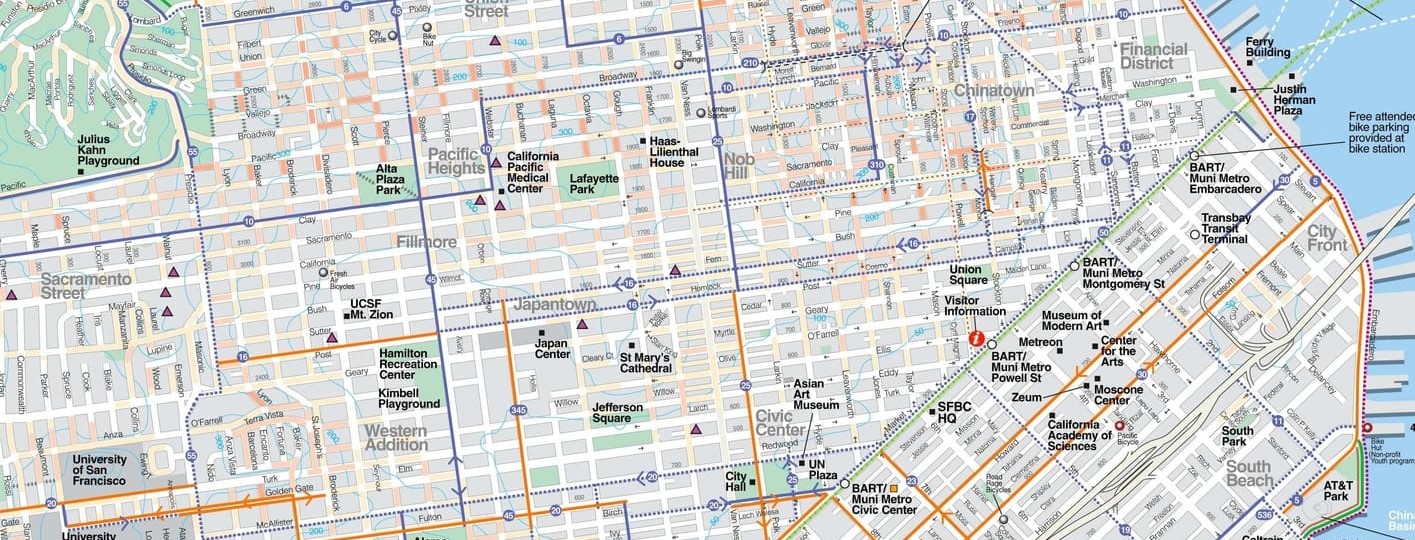
Maps of San Francisco: Tourist Map of SF, California
Home | Travel | North America | United States | California | San Francisco | Maps of San Francisco: Tourist Map of SF, California
Do you need a map of San Francisco for your trip? I have compiled the San Francisco maps that I consider most useful for planning a visit to this city and finding its most emblematic places, museums, parks, and much more.
You can print out or save on your smartphone the San Francisco maps below to always have them on hand and check them at any time.
In this article you will find the following 9 maps of San Francisco:
San Francisco tourist map
- Interactive map of SF
San Francisco street map
- Map of the San Francisco neighborhoods
- San Francisco transit map
San Francisco ferry map
- High-resolution map of SF
- Map of the United States
Map of San Francisco for downloading
With the tourist map of San Francisco below, you can get to know the must-see places in the city very quickly. This is an ideal map for those who don’t have too much time and want, at least, to visit the main San Francisco attractions.
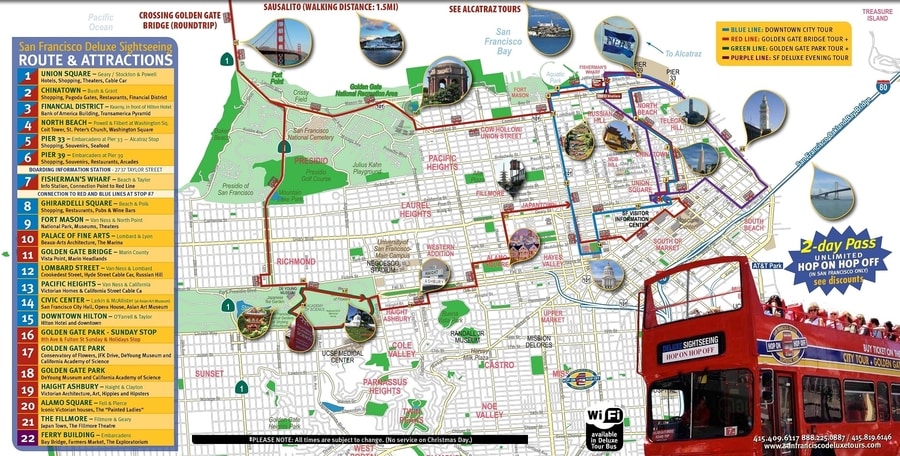
Interactive map of San Francisco
On the interactive map of San Francisco that I have created, I’ve marked the most interesting tourist attractions in the city such as museums, parks, gardens, beautiful streets, buildings of high architectural value, monuments, and much more.
If you know the city and think I’ve forgotten to pinpoint a sight that you consider important, leave a comment and I will add it.
In addition, at the end of the article, you can download the kml file of the San Francisco map so you can always have it with you during your visit to the city .
This street map of San Francisco will help you avoid getting lost in the city and find any point you want to go to. If you click on the map, you can see it in detail.
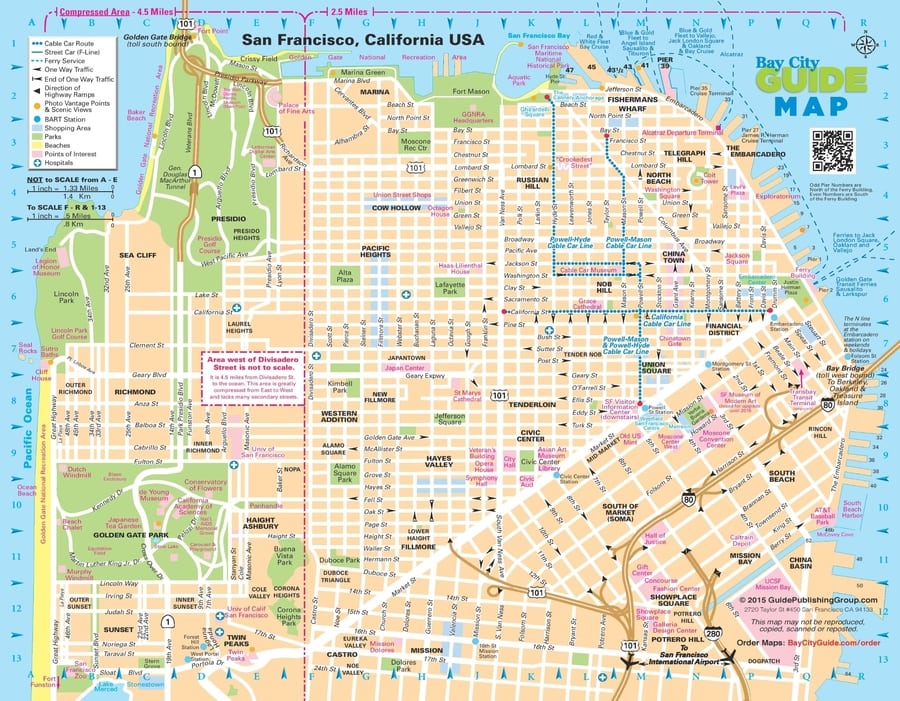
San Francisco Neighborhood Map
To make it easier for you to locate yourself and find tourist attractions, I’ve given you the following map of the San Francisco neighborhoods .

Also, here is an article where we tell you the best neighborhoods to stay in San Francisco .
San Francisco public transport map
To get around this big city, you will most likely need this public transport map of San Francisco . Driving through the city center is not recommended. Additionally, the SF public transport system is quite efficient, so use it to get everywhere.
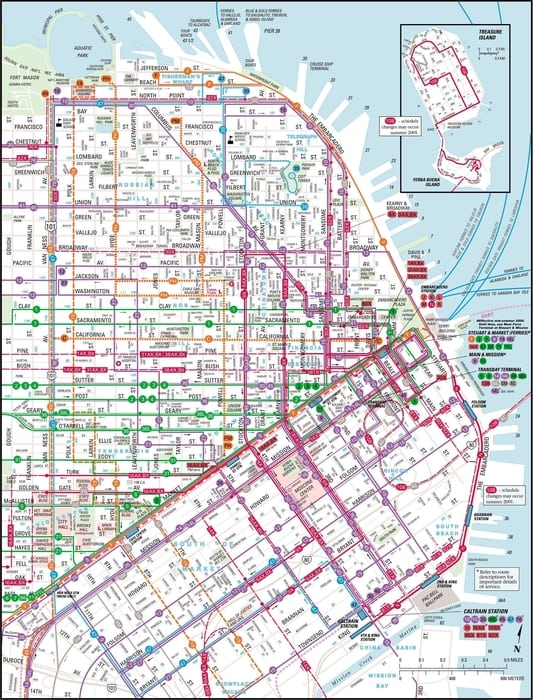
Here is a map of the San Francisco ferry in case you plan to visit, for example, Alcatraz or Angel Island.
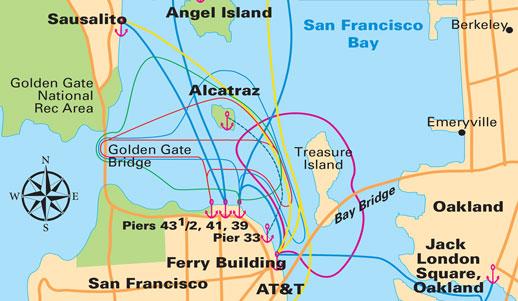
High-resolution map of San Francisco
To make sure you don’t miss any interesting street or place, here is a map of San Francisco with maximum resolution . You just have to zoom in to see everything much more clearly.
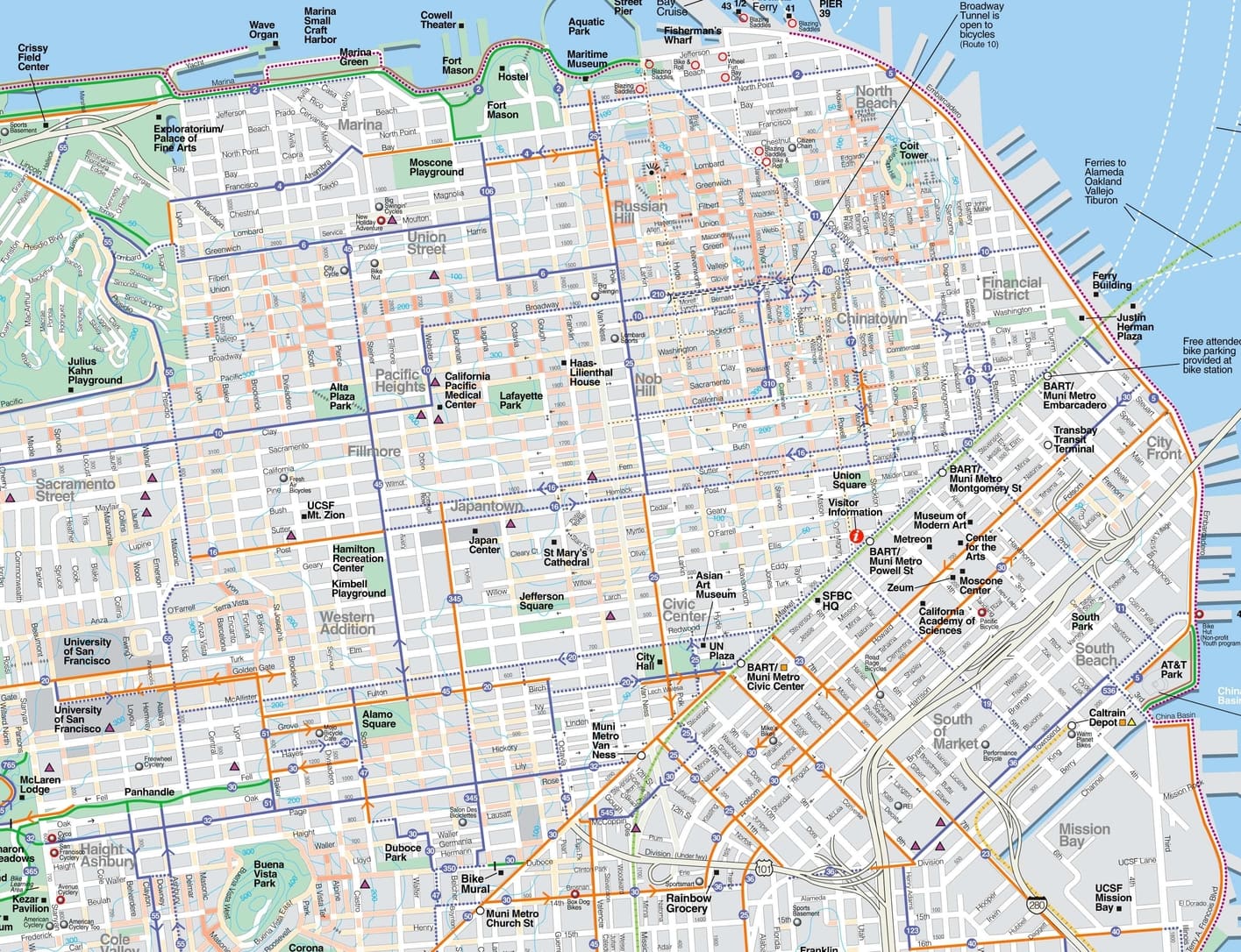
United States map
Here’s a map of the United States so you can locate the city of San Francisco within the country. As you can see, it is on the Pacific coast, in California.
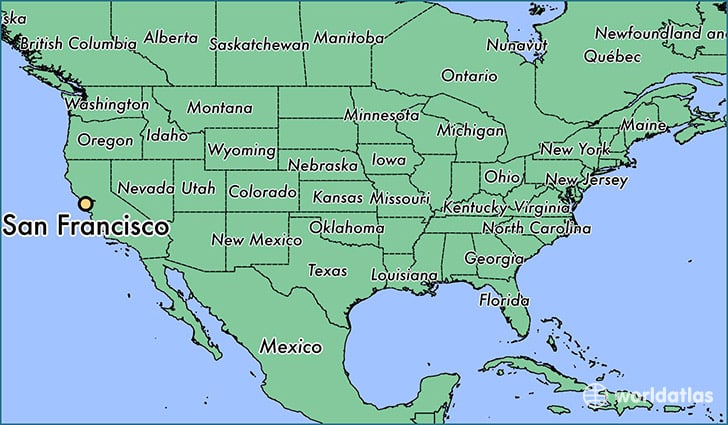
And finally, here is a map of San Francisco for downloading in kml format. Save it on your phone and you’ll be able to check it, even if you’re offline.

In order to use it, first download the Maps.me app and search for “San Francisco” in it to download the information. Then, open the kml file that you have downloaded and saved in Dropbox from your phone with the Map.me app. With this, you will be able to access all the points that we have pinpointed on our interactive map.
And that’s all. With the maps of San Francisco that I have compiled, you can now plan your trip and enjoy this beautiful city to the fullest.
Ascen Aynat
Leave a Reply Cancel reply
Your email address will not be published. Required fields are marked *
This site is protected by reCAPTCHA and the Google Privacy Policy and Terms of Service apply.

San Francisco Economic Recovery Dashboards
Data about the impact of the COVID-19 pandemic on the San Francisco economy and its progress towards economic recovery.
The COVID-19 pandemic deeply impacted the San Francisco economy. This page offers several metrics to help people understand how the city was impacted and track how it is recovering from the effects of the pandemic. To learn more about the City's economic recovery efforts, see the Roadmap to San Francisco's Future .
Data measures help us see how our economy has changed and how the city and our community have been impacted by these changes. We track measures about tourism, office attendance, jobs, and more to measure the state of our economy. We use maps and information on race and ethnicity, age, and gender to understand where changes have focused and whom has been impacted in what ways. This information gives us insight into what economic development strategies we might create to support the economic health of our city, to track the effectiveness of those strategies, and to inform our equitable response.
We are committed to providing accurate and reliable data to the public. The data notes on each dashboard explain data sources and limitations. The Office of Economic Analysis in the Office of the Controller also publishes a monthly “Status of the San Francisco Economy” report .
Economic Activity
Track how many San Franciscans moved into and out of the city each year.
Track how many workers are reporting in-person to the office each month.
Track the San Francisco tourism industry with monthly hotel data and quarterly airport data.
Track how many people are travelling to downtown on BART each month.
Economic Equity
Track unemployment and labor force data for San Francisco each month.
Track average annual unemployment by San Francisco ZIP code.
Track how much income San Franciscans have after paying rent and housing costs each year.
Economic Recovery
Track job trends in San Francisco industries each month.
Track supply of office space in San Francisco each quarter.
Track how much sales tax each San Francisco neighborhood produces each quarter.

IMAGES
VIDEO
COMMENTS
Tourists make important contributions to the San Francisco economy. In 2019, prior to the COVID-19 pandemic more than 26 million visitors travelled to San Francisco. Tourism for both business and leisure is a major source of revenue for local businesses and government. Tourist spending at hotels, restaurants, retail businesses, and other ...
San Francisco Visitor Volume, Direct Spending Estimates & Economic Impact (Summary) 2022. 2021. 2020. 2019. 2018. San Francisco Lodging Statistics (Summary)
By the numbers: Last year, San Francisco had 23.1 million visitors, a 5.2% increase from 2022, according to the San Francisco Travel Association. Those visitors spent $8.8 billion, an 18% year-over-year increase. Tourism ultimately generated nearly $610 million in tax revenue for the city in 2023, compared with $522 million in 2022.
How many tourists visit San Francisco each year? San Francisco consistently draws over 23 million visitors each year, excluding the pandemic period. 1. In 2019, the city reached its peak with 26.2 million visitors, including 2.95 million international visitors.; However, the COVID-19 pandemic caused a sharp decline in 2020, with only 11.8 million visitors, a 55% drop from the previous year ...
The tourism industry generated $257.4 million in taxes and fees for the City of San Francisco in 2021, down 6% from $273.4 million in 2020 and down 69% from $819.7 million in 2019. Major contributors to that figure include lodging tax (35%) and property tax (38%). Visitors spent $3,408 per San Francisco resident on a per capita basis, compared ...
San Francisco Travel is the official destination marketing organization for the City and County of San Francisco. The city is one of the top tourism and meetings destinations in the U.S., attracting over 23 million visitors annually. In 2023, total visitor-related spending contributed $9.3 billion into the San Francisco economy and supported ...
The 481,000 international visitors that San Francisco saw in 2021 were actually 4% lower than 2020 and down 84% from 2019's 2.9 million figure. While international visitors comprised only 11% of overnight visitor volume, they were responsible for 44% of all overnight visitor spending in 2021. The San Francisco Controller's Office agreed.
describes the impact to tourism demand for paid accommodations (volume) as well as the change in the share of visitors from different domestic origin markets (composition). Data is shown for the second quarter of 2021 (April to June) for California's tourism regions, with comparisons to Q2 2020 and Q2 2019.
In fact, San Francisco has the slowest downtown recovery of the 62 largest cities across the U.S. and Canada, according to an analysis from the School of Cities at the University of Toronto. By the numbers: Visitors to the city spent $7.4 billion last year, up from nearly $3.6 billion in 2021. Tourism generated $522 million in taxes and other ...
In 2021, San Francisco welcomed 14.8 million visitors to the city. This was an increase of 25% from 2020 — but down 44% from a record-high of 26.2 million visitors in 2019. SF Tourists in 2020. Only 10.2 million visitors traveled to San Francisco in 2020. The steep 61% decline from 2019 was due to the pandemic, which curbed domestic and ...
During that same period, the Hotel Occupancy Rate increased from a low of 13% to its peak of 79% in October 2023. The Hotel Occupancy Rate remains a key indicator of the City's recovery in the tourism sector since the pandemic. The interactive line chart below presents the monthly four-week rolling average of the San Francisco's Hotel Occupancy ...
It's now at 92.7% of what it was in 2019, which was roughly $145 billion. San Francisco's tourism recovery doesn't match those numbers, but the city has hugely improved since 2021. Visitor ...
After a steep drop in 2020, employment in the San Francisco metro division has risen by 7% since January, one of the fastest rates of any large metro area in the country. Despite the weakness in hotels and air travel, employment in the Leisure and Hospitality sector has led all sectors in employment growth, with 5,400 jobs added in July, and ...
The San Francisco Chained Activity Modeling Process, known as SF-CHAMP, is the city's travel forecasting tool. One of several analysis tools the Transportation Authority uses, SF-CHAMP predicts future travel patterns for the city. SF-CHAMP works by assessing the impacts of land use, socioeconomic, and transportation system changes and then ...
Total tourist spending was $2.3 billion, a 77.7% drop from the record-high $10.3 billion in 2019, according to San Francisco Travel, the city's tourism bureau.Total visitors were down 61%, to 10 ...
Newsom was celebrating the new numbers from Visit California's "Economic Impact of Travel in California 2014-2023" report, which indicated that in 2023, travel spending in California reached an ...
According to data from the San Francisco International Airport, the number of people getting on a plane in April - such as business and leisure tourists going home, and locals heading out - was still at 31% from the 2019 average. Part of this is the collapse in traffic between San Francisco and Asia (chart via the Office of Economic Analysis):
The average group daily rate was $383, higher than the top 25 average of $268 and up 2% from last year, Freitag said. The pandemic's long tail continues to whip at San Francisco's recovery ...
Brighten up your visit to San Francisco by attending these eclectic festivals and celebrations, some of which date back more than 100 years. Official site for planning a trip to San Francisco and Northern California. Find the latest on attractions, hotel rooms, restaurants, arts and culture, our neighborhoods, and more.
The San Francisco Travel Association reported Thursday morning that a record 26.2 million people visited the city in 2019, a 1.4% increase over 2018. It was the 10th straight year the visitor ...
In this article you will find the following 9 maps of San Francisco: San Francisco tourist map. Interactive map of SF. San Francisco street map. Map of the San Francisco neighborhoods. San Francisco transit map. San Francisco ferry map. High-resolution map of SF. Map of the United States.
Visitors Sub Category: Guides & Info. - Service 24x7. City and County of San Francisco. Get access to the Visitors guide including planning tools you need to prepare for your trip to San Francisco. The Guide includes a comprehensive map to the City and Bay Area, and filled with beautiful images of our City.
San Francisco Economic Recovery Dashboards. Data about the impact of the COVID-19 pandemic on the San Francisco economy and its progress towards economic recovery. The COVID-19 pandemic deeply impacted the San Francisco economy. This page offers several metrics to help people understand how the city was impacted and track how it is recovering ...
1388 Union St, San Francisco, CA 94109 is an apartment unit listed for rent at $3,595 /mo. The 850 Square Feet unit is a 1 bed, 1 bath apartment unit. View more property details, sales history, and Zestimate data on Zillow.